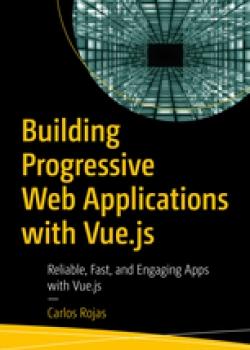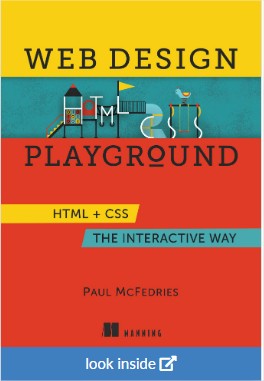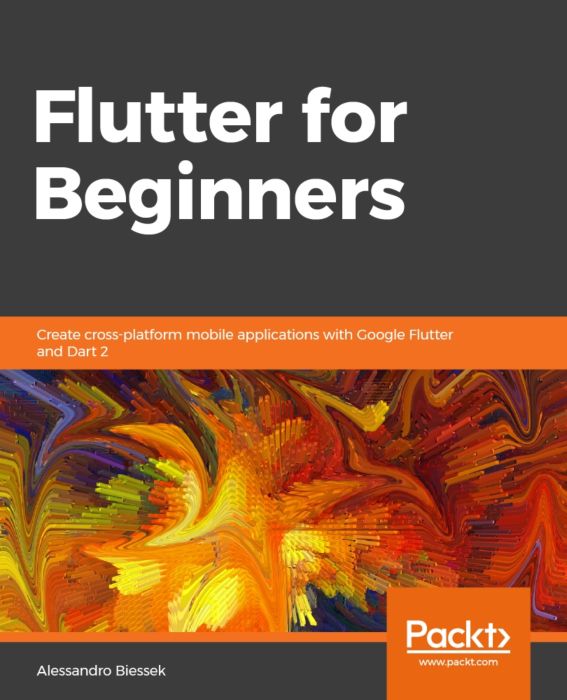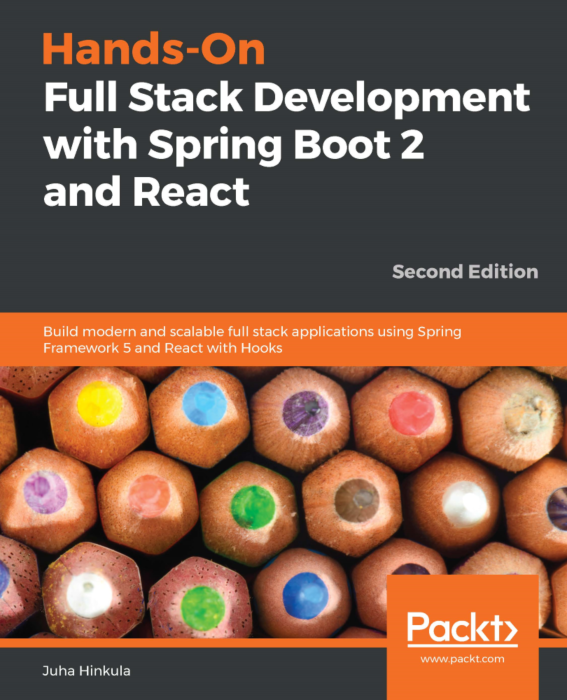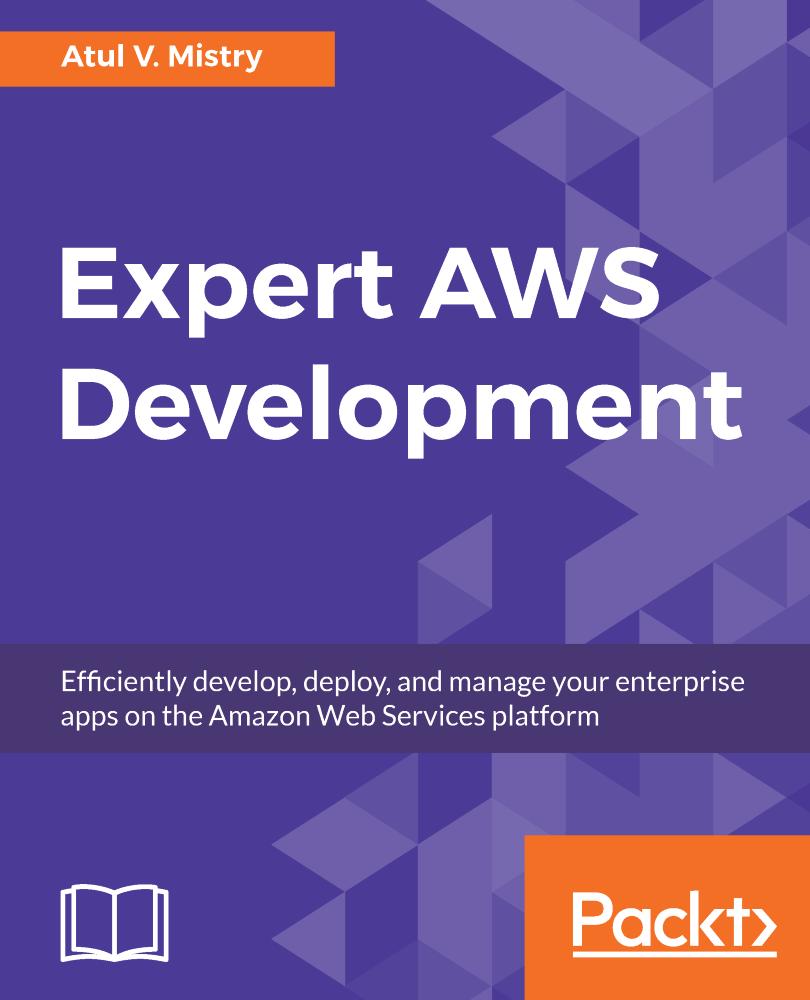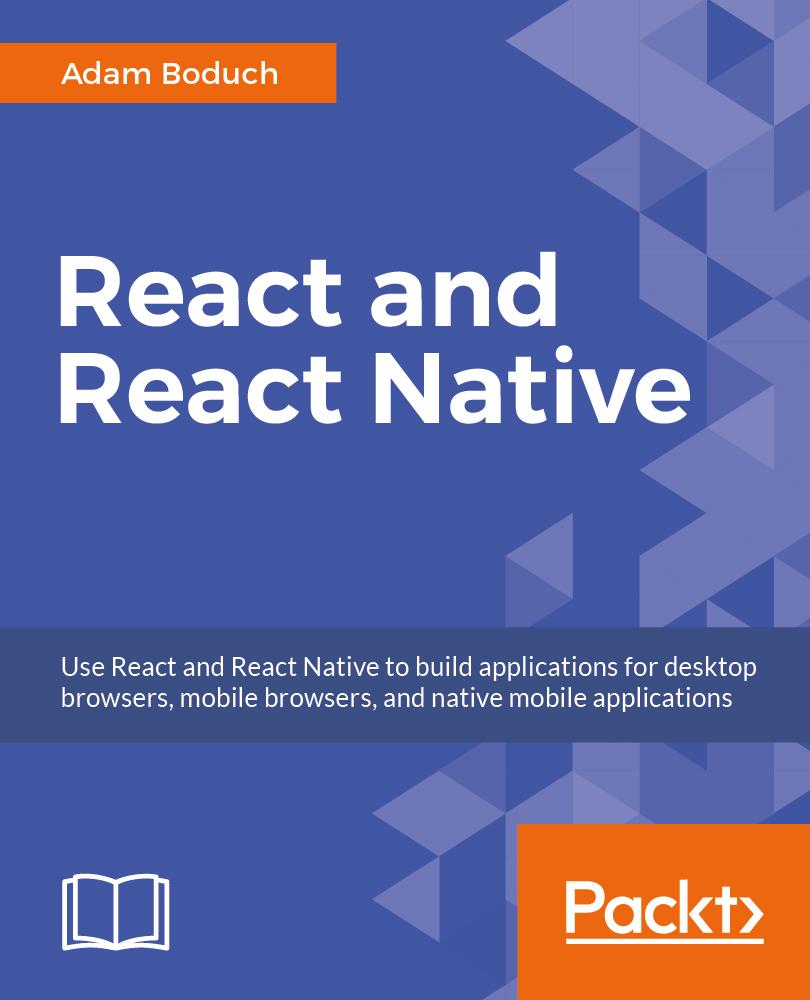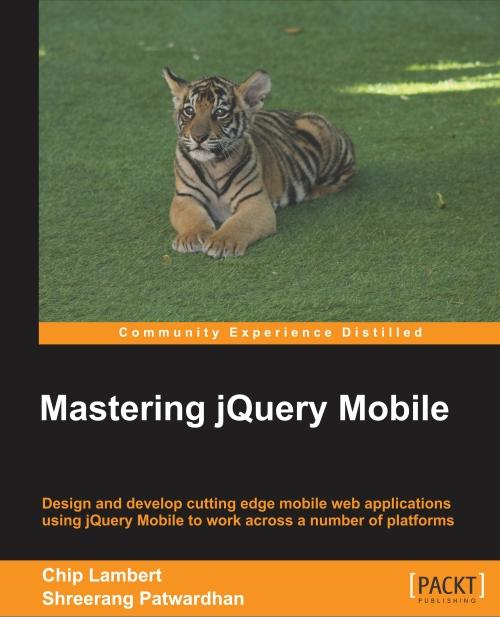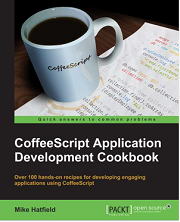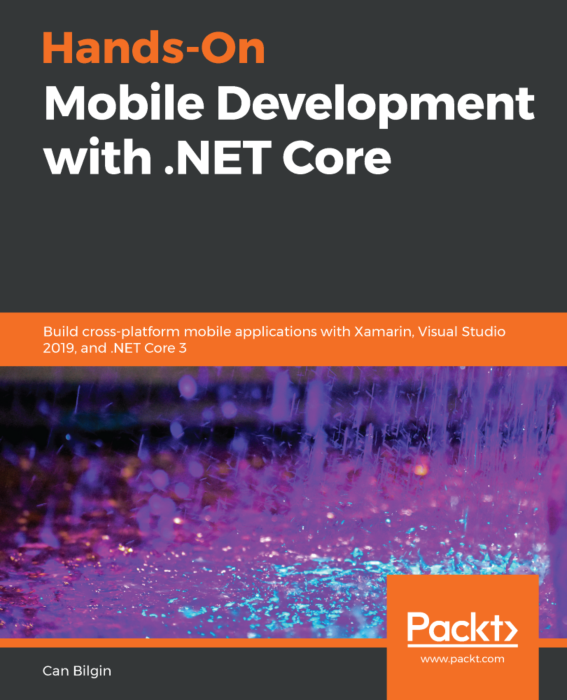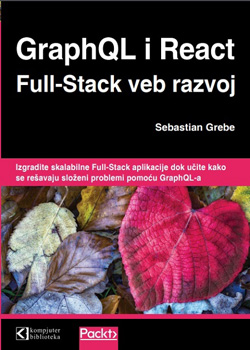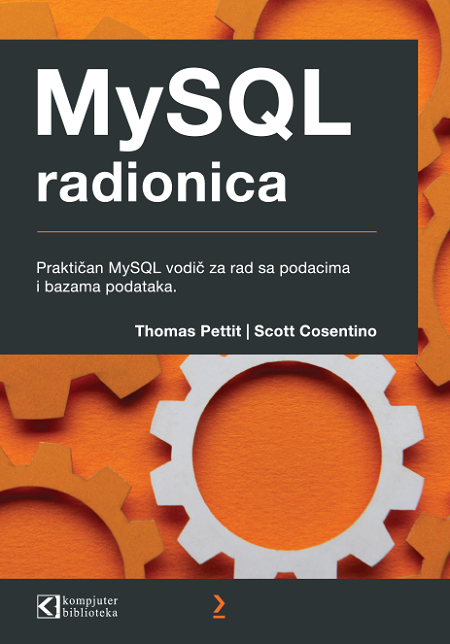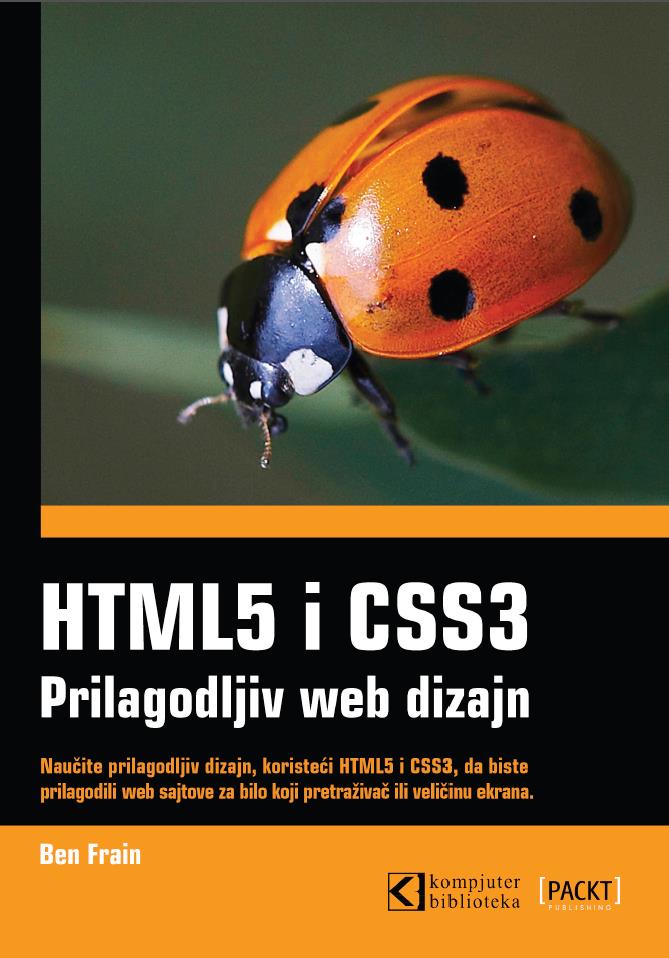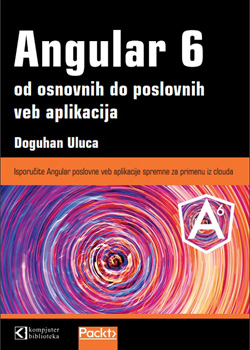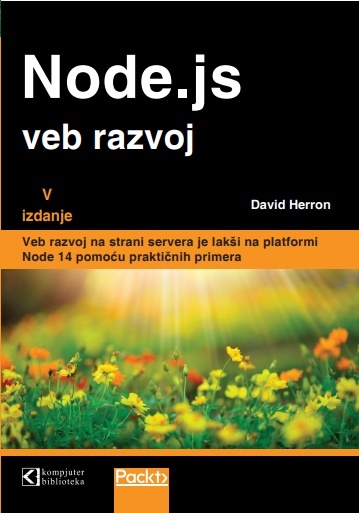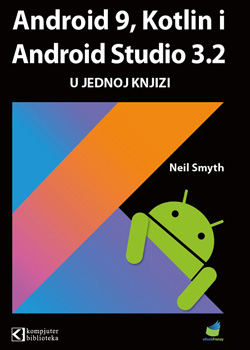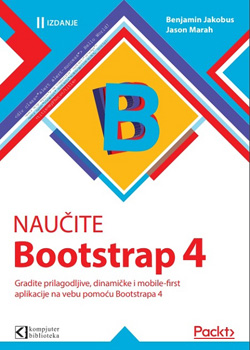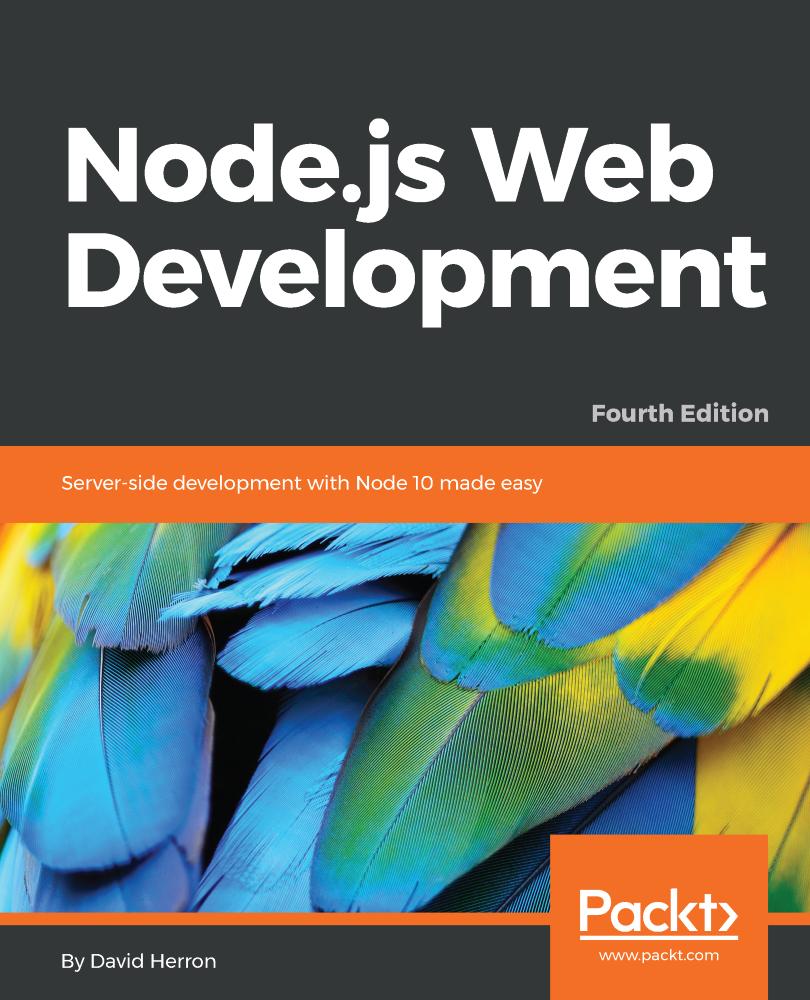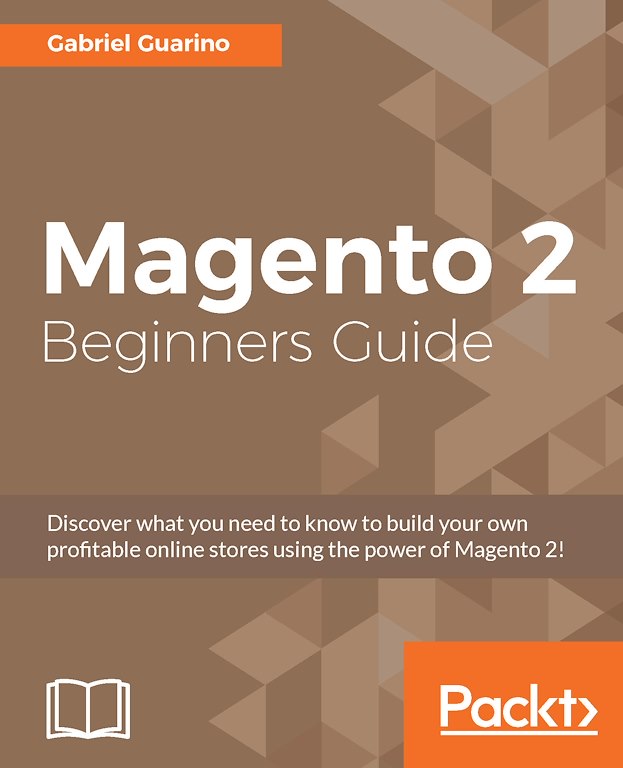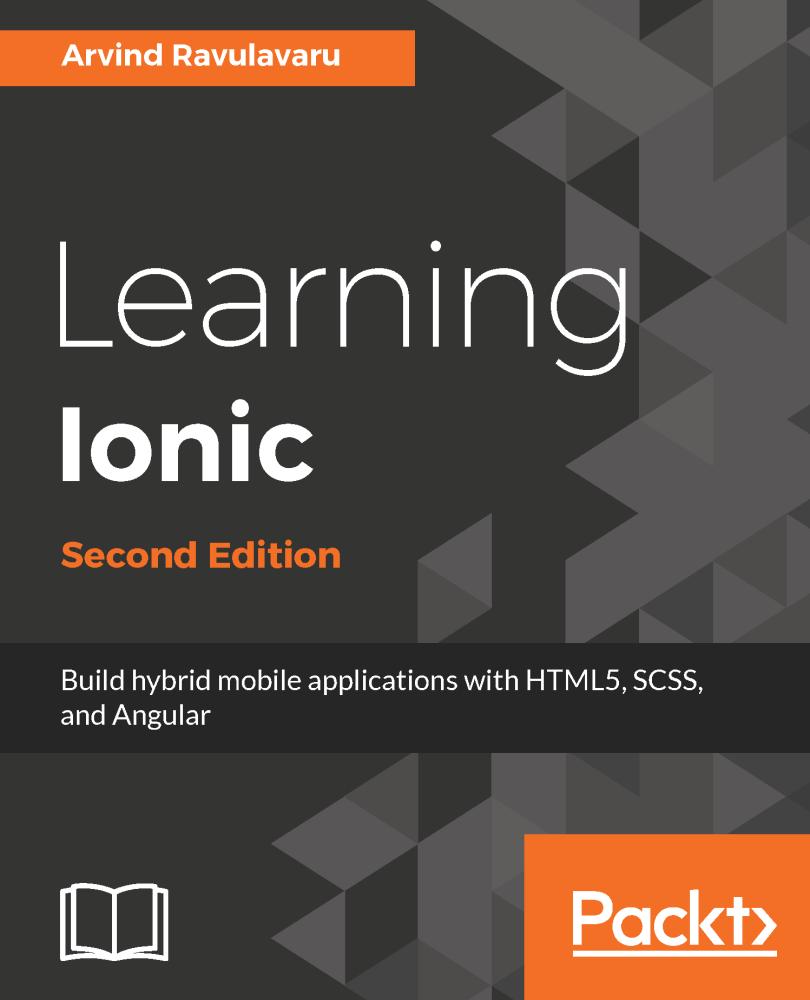Pratite promene cene putem maila
- Da bi dobijali obaveštenja o promeni cene potrebno je da kliknete Prati oglas dugme koje se nalazi na dnu svakog oglasa i unesete Vašu mail adresu.
101-125 od 144 rezultata
Režim promene aktivan!
Upravo ste u režimu promene sačuvane pretrage za frazu .
Možete da promenite frazu ili filtere i sačuvate trenutno stanje
Aktivni filteri
-
Tag
Web design
Obtain all the necessary tools for developing a progressive web application (PWA) with Vue.js, a modern JavaScript framework. You’ll see how PWAs behave like a regular responsive website and have a similar structure to that of a web application, but feel like a native mobile app. Along the way you’ll take advantage of Vue.js features to build fast, high-performing progressive web apps that work offline. Building Progressive Web Applications with Vue.js starts by explaining the basic concepts and structure of PWAs, and moves on to designing the app shell and other features that distinguish a PWA from simple web pages. In the following chapters, the book talks about the improved web technologies, such as service workers, caching strategies, background sync, and push notifications, that make PWAs powerful.What You Will Learn Harness the power of Vue.js to build PWAs Understand the function and relevance of a manifest file Discover service workers and why they are revolutionary Work with the Cache API and caching strategies Use IndexedDB, background sync, and push notifications Enhance your apps with Firebase Implement the Workbox library in your apps Who This Book Is ForWeb developers who want to venture into building PWAs would find the book useful. Table of contents Making Your First Progressive Web App Web App Manifest Service Workers Caching Strategies Working with Vue.js IndexedDB Background Sync Push Notifications Publishing
A wonderful guided tour of modern web design, replete with real-world examples that are relevant. Conor Redmond, Incomm Product Control Web Design Playground takes you step by step from writing your first line of HTML to creating interesting and attractive web pages. In this project-based book, you’ll use a custom online workspace, the book’s companion Playground, to design websites, product pages, photo galleries, and more. Part 1: Getting Started with HTML and CSS 1 Getting to Know HTML and CSS What Is HTML? What Is CSS? What Can’t You Do with HTML and CSS? How HTML and CSS Create the Web Introducing the Web Design Playground Adding HTML Tag Attributes Some Helpful Features of the Playground 2 Building Your First Web Page Getting Your Web Page off the Ground Learning the Most Common Text Elements 3 Adding Structure to Your Page HTML Elements for Structuring Page Text Organizing Text Into Lists 4 Formatting Your Web Page Styling Text Working with Text Styles Styling Paragraphs Working with Colors 5 Project: Creating a Personal Home Page What You’ll Be Building Sketching the Layout Choosing Typefaces Building the Page From Here Part 2: Working with Images and Styles 6 Adding Images and Other Media Understanding Image File Formats Getting Graphics Inserting an HTML5 Figure Setting Up an Image as a Link Using an Image as a Custom Bullet Aligning Images and Text Controlling the Background Repeat Setting the Background Position Adding a Hero Image The Background Shorthand Property Optimizing Images Adding Video and Audio to the Page 7 Learning More About Styles Adding Styles to a Page Units of Measurement in CSS 8 Floating and Positioning Elements Understanding the Default Page Flow 9 Styling Sizes, Borders, and Margins The Anatomy of an Element Box Watch Out for Collapsing Margins! 10 Project: Creating a Landing Page What You’ll Be Building Sketching the Layout Choosing Typefaces Choosing a Color Scheme Building the Page From Here Part 3: Laying Out a Web Page 11 Learning Page Layout Basics The Holy-Grail Layout Understanding Web Page Layout Methods Learning the HTML5 Semantic Page Elements Creating Page Layouts with Floats Creating Page Layouts with Inline Blocks 12 Creating Page Layouts with Flexbox Understanding Flexbox 13 Designing Responsive Web Pages Creating a Responsive Layout 14 Making Your Images and Typography Responsive Making Images Responsive Making Typography Responsive Making Your Images and Typography Responsive Gallery of Responsive Sites 15 Project: Creating a Photo Gallery What You’ll Be Building Getting Your Photos Ready Sketching the Layout Choosing Typefaces Choosing the Colors Building the Page Adding a Few Tricks From Here Part 4: Making Your Web Pages Shine 16 More HTML Elements for Web Designers More about Links Inserting Special Characters Using the HTML5 Entity Browser More HTML Elements for Web Designers Adding Comments Summary 17 Adding a Splash of Color to Your Web Designs Understanding Colors Adding Colors with CSS Choosing Harmonious Colors Using the Color Scheme Calculator Color Scheme Gallery Applying a Color Gradient Summary 18 Enhancing Page Text with Typography Specifying the Typeface Working with Text Styles Enhancing Page Text with Typography Web Typography Gallery Enhancing Page Text with Typography Summary 19 Learning Advanced CSS Selectors Working with ID Selectors Web Page Genealogy: Parents, Descendants, and Siblings Working with Contextual Selectors Taking Things up a Notch by Combining Selectors Resetting CSS with the Universal Selector Styles: What a Tangled Web Page They Weave 20 Project: Creating a Portfolio Page What You’ll Be Building Sketching the Layout Choosing Typefaces Choosing a Color Scheme Building the Page Building the Page From Here Appendixes Appendix A: Appendix From Playground to Web: Getting Your Pages Online From There to Here: Saving Your Playground Work Setting Up Your Folders Validating Your Code Getting a Web Host Uploading Your Files Selecting a Text Editor About the Technology How do top designers learn to create beautiful web pages and intuitive user experiences? Great examples, expert mentoring, and lots of practice! Written by web designer and master teacher Paul McFedries, this unique book shapes and sharpens your skills in HTML, CSS, and web page design. About the book Web Design Playground takes you step by step from writing your first line of HTML to creating interesting, attractive web pages. In this project-based book, you’ll use a custom online workspace to design websites, product pages, photo galleries, and more. Don’t worry about setting up your own servers and domain names—the book comes with a free “playground” which lets you experiment without any of that! You can concentrate on core skills like adding images and video and laying out the page, plus learning typography, responsive design, and the other tools of the web trade. What's inside Getting started with HTML, CSS, and web design A free, fully interactive web design workspace Working with images, color, and fonts Full-color illustrations throughout About the reader If you can use a browser, you’re ready to create web pages! About the author Paul McFedries has written nearly 100 books, which have sold over four million copies world-wide.
Understand the fundamentals of the Dart programming language Explore the core concepts of the Flutter UI and how it compiles for multiple platforms Develop Flutter plugins and widgets and understand how to structure good plugin code Style your apps with widgets and learn the difference between stateful and stateless widgets Add animation to your UI using Flutter's AnimatedBuilder component Integrate your native code into your Flutter codebase for native app performance Google Flutter is a cross-platform mobile platform that makes it easier to write secure and high-performance native apps for iOS and Android. This book begins by introducing you to the Flutter framework and basics of Dart. You’ll learn to set up the development environment to get started with your Flutter project. The book will guide you through designing the user interface and user input functions for your app. As you progress, you’ll explore the navigator widget to manage your app routes and understand how to add transitions between screens. You’ll then get to grips with developing your own plugin and discover how to structure good plugin code. The book will help you display a map from the Flutter app, add markers and interactions to it, and use the Google Places API. You’ll build on your knowledge by not only adding tests to create a bug-free app, but also preparing it for deployment on Apple's App Store and Google Play. In later chapters, you’ll learn to improve the user experience with advanced features such as map integrations, platform-specific code with native programming languages, and personalized animation options for designing intuitive UIs. By the end of this book, you’ll be well-versed with Dart programming and have the skills to develop your own mobile apps or build a career as a Dart and Flutter app developer. Get up to speed with the basics of Dart programming and delve into Flutter development Understand native SDK and third-party libraries for building Android and iOS applications using Flutter Package and deploy your Flutter apps to achieve native-like performance Table of contents 1 An Introduction to Dart Getting started with Dart Understanding why Flutter uses Dart Introducing the structure of the Dart language Introduction to OOP in Dart Summary Further reading 2 Intermediate Dart Programming Dart classes and constructors Interfaces, abstract classes, and mixins Understanding Dart libraries and packages Introducing async programming with Futures and Isolates Introducing unit testing with Dart Summary 3 An Introduction to Flutter Comparisons with other mobile app development frameworks Flutter compilation (Dart) Flutter rendering Widgets introduction Hello Flutter Summary 4 Widgets: Building Layouts in Flutter Stateful versus stateless widgets Built-in widgets Understanding built-in layout widgets Creating a UI with widgets (favor manager app) Creating custom widgets Summary 5 Handling User Input and Gestures Handling user gestures Input widgets Validating Input (Forms) Custom input and FormField Putting it all together Summary 6 Theming and Styling Theme widgets Material Design iOS Cupertino Using custom fonts Dynamic styling with MediaQuery and LayoutBuilder Summary 7 Routing: Navigating between Screens Understanding the Navigator widget Named routes Screen transitions Hero animations Summary 8 Firebase Plugins Firebase overview Firebase authentication NoSQL database with Cloud Firestore Cloud Storage with Firebase Storage Ads with Firebase AdMob ML with Firebase ML Kit Summary 9 Developing Your Own Flutter Plugin Creating a package/plugin project A plugin project structure Adding documentation to the package Publishing a package Plugin project development recommendations Summary 10 Accessing Device Features from the Flutter App Launching a URL from the app Managing app permissions Importing a contact from the phone Integrating the phone's camera Summary 11 Platform Views and Map Integration Displaying a map Adding markers to the map Adding map interactions Using the Google Places API Summary 12 Testing, Debugging, and Deployment Flutter testing – unit and widget testing Debugging Flutter apps Profiling Flutter apps Inspecting the Flutter widget tree Preparing apps for deployment Summary 13 Improving User Experience Accessibility in Flutter and adding translations to apps Communication between native and Flutter with platform channels Creating background processes Adding Android-specific code to run Dart code in the background Adding iOS-specific code to run Dart code in the background Summary 14 Widget Graphic Manipulations Transforming widgets with the Transform class Exploring the types of transformations Applying transformations to your widgets Using custom painters and canvas Summary 15 Animations Introducing Animations Using animations Using AnimatedBuilder Using AnimatedWidget Summary
DESCRIPTION Distributed systems are unpredictable, and it can be an enormous challenge to manage around potentially-crippling obstacles like hardware failures, unanticipated changes in load, and network issues. Amazon Web Services (AWS) is a platform for hosting distributed applications in a secure, flexible cloud environment. AWS provides a suite of services designed to keep the focus on what an application does instead of the infrastructure required to run it. Whether serving up blog pages, analyzing fast data in real-time, building software as a service, or implementing a massive e-commerce site, AWS provides both a stable platform and services that will scale with every application. Amazon Web Services in Action introduces readers to computing, storing, and networking in the AWS cloud. It starts with a broad overview of AWS, and shows how to spin up servers manually and from the command line. Then, it explores infrastructure automation with the AWS CloudFormation service, where readers can describe a blueprint of their infrastructure as code. Readers will learn how to isolate systems using private networks to increase security, how to use the most valuable AWS managed services available on AWS, and about the benefits of stateless servers. In the end, they’ll look to the AWS model for high availability, scaling, decoupling with queues and load balancers, and fault tolerance. KEY SELLING POINTS Explains the key concepts of AWS Gives an overview of the most important services Allows readers to take full advantage of the AWS platform AUDIENCE Written for developers and DevOps engineers who are moving traditionally-deployed distributed applications to the AWS platform. No experience with AWS is required. ABOUT THE TECHNOLOGY Amazon Web Services is a platform of services in the Cloud to provide everything needed to run applications—from hosting a private blog, to running one of the biggest websites on earth, analyzing data for cancer research, or providing business applications. TABLE OF CONTENTS FOREWORD PREFACE ACKNOWLEDGMENTS ABOUT THIS BOOK AUTHOR ONLINE ABOUT THE AUTHORS ABOUT THE COVER ILLUSTRATION PART 1: GETTING STARTED 1. WHAT IS AMAZON WEB SERVICES? 1.1. What is cloud computing? 1.2. What can you do with AWS? 1.2.1. Hosting a web shop 1.2.2. Running a Java EE application in your private network 1.2.3. Meeting legal and business data archival requirements 1.2.4. Implementing a fault-tolerant system architecture 1.3. How you can benefit from using AWS 1.3.1. Innovative and fast-growing platform 1.3.2. Services solve common problems 1.3.3. Enabling automation 1.3.4. Flexible capacity (scalability) 1.3.5. Built for failure (reliability) 1.3.6. Reducing time to market 1.3.7. Benefiting from economies of scale 1.3.8. Worldwide 1.3.9. Professional partner 1.4. How much does it cost? 1.4.1. Free Tier 1.4.2. Billing example 1.4.3. Pay-per-use opportunities 1.5. Comparing alternatives 1.6. Exploring AWS services 1.7. Interacting with AWS 1.7.1. Management Console 1.7.2. Command-line interface 1.7.3. SDKs 1.7.4. Blueprints 1.8. Creating an AWS account 1.8.1. Signing up 1.8.2. Signing In 1.8.3. Creating a key pair 1.8.4. Creating a billing alarm 1.9. Summary 2. A SIMPLE EXAMPLE: WORDPRESS IN FIVE MINUTES 2.1. Creating your infrastructure 2.2. Exploring your infrastructure 2.2.1. Resource groups 2.2.2. Web servers 2.2.3. Load balancer 2.2.4. MySQL database 2.3. How much does it cost? 2.4. Deleting your infrastructure 2.5. Summary PART 2: BUILDING VIRTUAL INFRASTRUCTURE CONSISTING OF SERVERS AND NETWORKING 3. USING VIRTUAL SERVERS: AMAZON EC2 3.1. Exploring a virtual server 3.1.1. Launching a virtual server 3.1.2. Connecting to a virtual server 3.1.3. Installing and running software manually 3.2. Monitoring and debugging a virtual server 3.2.1. Showing logs from a virtual server 3.2.2. Monitoring the load of a virtual server 3.3. Shutting down a virtual server 3.4. Changing the size of a virtual server 3.5. Starting a virtual server in another data center 3.6. Allocating a public IP address 3.7. Adding an additional network interface to a virtual server 3.8. Optimizing costs for virtual servers 3.8.1. Reserve virtual servers 3.8.2. Bidding on unused virtual servers 3.9. Summary 4. PROGRAMMING YOUR INFRASTRUCTURE: THE COMMAND-LINE INTERFACE, SDKS, AND AWS CLOUDFORMATION 4.1. Infrastructure as code 4.1.1. Automation and the DevOps movement 4.1.2. Inventing an infrastructure language: JIML 4.2. Using the command-line interface 4.2.1. Installing the CLI 4.2.2. Configuring the CLI 4.2.3. Using the CLI 4.3. Programming with the SDK 4.3.1. Controlling virtual servers with SDK: nodecc 4.3.2. How nodecc creates a server 4.3.3. How nodecc lists servers and shows server details 4.3.4. How nodecc terminates a server 4.4. Using a blueprint to start a virtual server 4.4.1. Anatomy of a CloudFormation template 4.4.2. Creating your first template 4.5. Summary 5. AUTOMATING DEPLOYMENT: CLOUDFORMATION, ELASTIC BEANSTALK, AND OPSWORKS 5.1. Deploying applications in a flexible cloud environment 5.2. Running a script on server startup using CloudFormation 5.2.1. Using user data to run a script on server startup 5.2.2. Deploying OpenSwan as a VPN server to a virtual server 5.2.3. Starting from scratch instead of updating 5.3. Deploying a simple web application with Elastic Beanstalk 5.3.1. Components of Elastic Beanstalk 5.3.2. Using Elastic Beanstalk to deploy Etherpad, a Node.js application 5.4. Deploying a multilayer application with OpsWorks 5.4.1. Components of OpsWorks 5.4.2. Using OpsWorks to deploy an IRC chat application 5.5. Comparing deployment tools 5.5.1. Classifying the deployment tools 5.5.2. Comparing the deployment services 5.6. Summary 6. SECURING YOUR SYSTEM: IAM, SECURITY GROUPS, AND VPC 6.1. Who's responsible for security? 6.2. Keeping your software up to date 6.2.1. Checking for security updates 6.2.2. Installing security updates on server startup 6.2.3. Installing security updates on running servers 6.3. Securing your AWS account 6.3.1. Securing your AWS account's root user 6.3.2. Identity and Access Management service 6.3.3. Policies for authorization 6.3.4. Users for authentication, and groups to organize users 6.3.5. Roles for authentication of AWS resources 6.4. Controlling network traffic to and from your virtual server 6.4.1. Controlling traffic to virtual servers with security groups 6.4.2. Allowing ICMP traffic 6.4.3. Allowing SSH traffic 6.4.4. Allowing SSH traffic from a source IP address 6.4.5. Allowing SSH traffic from a source security group 6.4.6. Agent forwarding with PuTTY 6.5. Creating a private network in the cloud: Amazon Virtual Private Cloud (VPC) 6.5.1. Creating the VPC and an internet gateway (IGW) 6.5.2. Defining the public bastion host subnet 6.5.3. Adding the private Apache web server subnet 6.5.4. Launching servers in the subnets 6.5.5. Accessing the internet from private subnets via a NAT server 6.6. Summary PART 3: STORING DATA IN THE CLOUD 7. STORING YOUR OBJECTS: AMAZON S3 AND AMAZON GLACIER 7.1. Concept of an object store 7.2. Amazon S3 7.3. Backing up your data 7.4. Archiving objects to optimize costs 7.4.1. Creating an S3 bucket for the use with Glacier 7.4.2. Adding a lifecycle rule to a bucket 7.4.3. Experimenting with Glacier and your lifecycle rule 7.5. Storing objects programmatically 7.5.1. Setting up an S3 bucket 7.5.2. Installing a web application that uses S3 7.5.3. Reviewing code access S3 with SDK 7.6. Using S3 for static web hosting 7.6.1. Creating a bucket and uploading a static website 7.6.2. Configuring a bucket for static web hosting 7.6.3. Accessing a website hosted on S3 7.7. Internals of the object store 7.7.1. Ensuring data consistency 7.7.2. Choosing the right keys 7.8. Summary 8. STORING YOUR DATA ON HARD DRIVES: EBS AND INSTANCE STORES 8.1. Network-attached storage 8.1.1. Creating an EBS volume and attaching it to your server 8.1.2. Using Elastic Block Store 8.1.3. Tweaking performance 8.1.4. Backing up your data 8.2. Instance stores 8.2.1. Using an instance store 8.2.2. Testing performance 8.2.3. Backing up your data 8.3. Comparing block-level storage solutions 8.4. Hosting a shared file system backed by an instance store and EBS 8.4.1. Security groups for NFS 8.4.2. NFS server and volume 8.4.3. NFS server installation and configuration script 8.4.4. NFS clients 8.4.5. Sharing files via NFS 8.5. Summary 9. USING A RELATIONAL DATABASE SERVICE: RDS 9.1. Starting a MySQL database 9.1.1. Launching a WordPress platform with an Amazon RDS database 9.1.2. Exploring an RDS database instance with a MySQL engine 9.1.3. Pricing for Amazon RDS 9.2. Importing data into a database 9.3. Backing up and restoring your database 9.3.1. Configuring automated snapshots 9.3.2. Creating snapshots manually 9.3.3. Restoring a database 9.3.4. Copying a database to another region 9.3.5. Calculating the cost of snapshots 9.4. Controlling access to a database 9.4.1. Controlling access to the configuration of an RDS database 9.4.2. Controlling network access to an RDS database 9.4.3. Controlling data access 9.5. Relying on a highly available database 9.5.1. Enabling high-availability deployment for an RDS database 9.6. Tweaking database performance 9.6.1. Increasing database resources 9.6.2. Using read replication to increase read performance 9.7. Monitoring a database 9.8. Summary 10. PROGRAMMING FOR THE NOSQL DATABASE SERVICE: DYNAMODB 10.1. Operating DynamoDB 10.1.1. Administration 10.1.2. Pricing 10.1.3. RDS comparison 10.2. DynamoDB for developers 10.2.1. Tables, items, and attributes 10.2.2. Primary keys 10.2.3. NoSQL comparison 10.2.4. DynamoDB Local 10.3. Programming a to-do application 10.4. Creating tables 10.4.1. Users with hash keys 10.4.2. Tasks with hash and range keys 10.5. Adding data 10.5.1. Adding a user 10.5.2. Adding a task 10.6. Retrieving data 10.6.1. Getting by key 10.6.2. Querying by key and filter 10.6.3. Using secondary indexes for more flexible queries 10.6.4. Scanning and filtering all of your table's data 10.6.5. Eventually consistent data retrieval 10.7. Removing data 10.8. Modifying data 10.9. Scaling capacity 10.10. Summary PART 4: ARCHITECTING ON AWS 11. ACHIEVING HIGH AVAILABILITY: AVAILABILITY ZONES, AUTO-SCALING, AND CLOUDWATCH 11.1. Recovering from server failure with CloudWatch 11.1.1. Creating a CloudWatch alarm 11.1.2. Monitoring and recovering a virtual server based on a CloudWatch alarm 11.2. Recovering from a data center outage 11.2.1. Availability zones: multiple data centers per region 11.2.2. Using auto-scaling to ensure that a virtual server is always running 11.2.3. Recovering a failed virtual server to another availability zone with the help of auto-scaling 11.2.4. Pitfall: network-attached storage recovery 11.2.5. Pitfall: network interface recovery 11.3. Analyzing disaster-recovery requirements 11.3.1. RTO and RPO comparison for a single virtual server 11.4. Summary 12. DECOUPLING YOUR INFRASTRUCTURE: ELB AND SQS 12.1. Synchronous decoupling with load balancers 12.1.1. Setting up a load balancer with virtual servers 12.1.2. Pitfall: connecting a server too early 12.1.3. More use cases 12.2. Asynchronous decoupling with message queues 12.2.1. Turning a synchronous process into an asynchronous one 12.2.2. Architecture of the URL2PNG application 12.2.3. Setting up a message queue 12.2.4. Producing messages programmatically 12.2.5. Consuming messages programmatically 12.2.6. Limitations of messaging with SQS 12.3. Summary 13. DESIGNING FOR FAULT-TOLERANCE 13.1. Using redundant EC2 instances to increase availability 13.1.1. Redundancy can remove a single point of failure 13.1.2. Redundancy requires decoupling 13.2. Considerations for making your code fault-tolerant 13.2.1. Let it crash, but also retry 13.2.2. Idempotent retry makes fault-tolerance possible 13.3. Architecting a fault-tolerant web application: Imagery 13.3.1. The idempotent image-state machine 13.3.2. Implementing a fault-tolerant web service 13.3.3. Implementing a fault-tolerant worker to consume SQS messages 13.3.4. Deploying the application 13.4. Summary 14. SCALING UP AND DOWN: AUTO-SCALING AND CLOUDWATCH
About This Book Develop apps for the modern web using Dart and HTML5 Clarify and shorten your Dart code using enums Build a complex UI for business applications with Dart's Polymer framework, based on web components Who This Book Is For If you want to become a developer for the modern web, or wish to add Dart to your tool belt, then this book is for you. The book assumes you have basic HTML experience and know how web applications work. Some previous programming experience, preferably in a modern language like C#, Java, Python, Ruby or JavaScript, will give you a head start. You can work with Dart on your preferred platform, be it Linux, Mac OS X or Windows. What You Will Learn Structure your code using functions, classes, generics, packages and libraries Use the power of modern browsers to process and store data Make games by drawing, and using audio and video in the browser Develop an application with a model-driven and spiral-paced approach Discover the Observatory tools for profiling memory and CPU usage of Dart programs Store your app's data in MySQL and MongoDB through Dart Build powerful HTML5 forms, validate and store data in local storage, and use web components to build your own user interface Run your Dart server on an App Engine Managed VM In Detail Dart is an open source programming language for the web, developed at Google, with a steadily growing community. It is a single language for both client and server, appropriate for the full range of devices on the web – including phones, tablets, laptops, and servers. It encompasses the lessons of the last two decades of web programming. This book will give you a thorough overview of Dart, taking you through its ecosystem, syntax, and development principles. With this book, you will build web games using HTML5, audio, and video, and also dive into processing and displaying data in HTML5 forms with Dart. You will also learn how web components fit together with HTML5, and how to apply them in business web applications of the future. You will discover how to store data on the client, communicate data between client and server with JSON, and store JSON data with MongoDB and MySQL. Stop solving new challenges with the same old tools – let Dart show you a whole new way. Authors Ivo Balbaert Ivo Balbaert is currently Lecturer (web) Programming and Databases at CVO Antwerpen, a community college in Belgium. He received a Ph.D. in Applied Physics from the University of Antwerp in 1986. He worked for 20 years in the software industry as a developer and consultant in several companies, and for 10 years as project manager at the University Hospital of Antwerp. From 2000 onwards he switched to partly teaching and partly developing software (KHM Mechelen, CVO Antwerp). Ivo also wrote an introductory book in Dutch about developing in Ruby and Rails: Programmeren met Ruby en Rails, Van Duuren Media. In 2012 he authored a book on the Go programming language: The Way to Go. He wrote the first edition of Learning Dart in 2013 in collaboration with Dzenan Ridzanovic. His other work for Packt includes: Dart Cookbook (2013), Getting started with Julia (2014) and Rust Essentials (2015). Dzenan Ridjanovic Dzenan Ridjanovic is a university professor who is planning his early retirement to focus on the development of web applications with Dart, HTML5, web components, and NoSQL databases. For more than 10 years, he was a Director of Research and Development in the Silverrun team (http://www.silverrun.com/), which created several commercial tools for analysis, design, and development of data-driven applications. He was a principal developer of Modelibra (http://www.modelibra.org/) tools and frameworks for model-driven development in Java. Recently, he has been developing the Dartling framework for design and code generation of Dart models. His projects are at GitHub (https://github.com/dzenanr), where he is considered a Dart expert (http://osrc.dfm.io/dzenanr). He writes about his projects at On Dart blog (http://dzenanr.github.io/). His courses are available at On Dart Education (http://ondart.me/). He markets his Dart efforts at On Dart G+ Page (https://plus.google.com/+OndartMe). Dzenan Ridjanovic wrote a book in 2009, under the Creative Commons License, entitled Spiral Development of Dynamic Web Applications: Using Modelibra and Wicket (http://www.modelibra.org/). Table of Contents
Create a RESTful web service with Spring Boot Grasp the fundamentals of dependency injection and how to use it for backend development Discover techniques for securing the backend using Spring Security Understand how to use React for frontend programming Benefit from the Heroku cloud server by deploying your application to it Delve into the techniques for creating unit tests using JUnit Explore the Material UI component library to make more user-friendly user interfaces React Hooks have changed the way React components are coded. They enable you to write components in a more intuitive way without using classes, which makes your code easier to read and maintain. Building on from the previous edition, this book is updated with React Hooks and the latest changes introduced in create-react-app and Spring Boot 2.1. This book starts with a brief introduction to Spring Boot. You’ll understand how to use dependency injection and work with the data access layer of Spring using Hibernate as the ORM tool. You’ll then learn how to build your own RESTful API endpoints for web applications. As you advance, the book introduces you to other Spring components, such as Spring Security to help you secure the backend. Moving on, you’ll explore React and its app development environment and components for building your frontend. Finally, you’ll create a Docker container for your application by implementing the best practices that underpin professional full stack web development. By the end of this book, you’ll be equipped with all the knowledge you need to build modern full stack applications with Spring Boot for the backend and React for the frontend. Unleash the power of React Hooks to build interactive and complex user interfaces Build scalable full stack applications designed to meet demands of modern users Understand how the Axios library simplifies CRUD operations Table of contents 1 Setting Up the Environment and Tools - Backend Technical requirements Setting up the environment and tools Summary Questions Further reading 2 Dependency Injection Technical requirements Introducing DI Summary Questions Further reading 3 Using JPA to Create and Access a Database Technical requirements Basics of ORM, JPA, and Hibernate Summary Questions Further reading 4 Creating a RESTful Web Service with Spring Boot Technical requirements Basics of REST Summary Questions Further reading 5 Securing and Testing Your Backend Technical requirements Spring Security Securing your backend using JWT Testing in Spring Boot Creating unit tests Summary Questions Further reading 6 Setting Up the Environment and Tools - Frontend Technical requirements Installing Node.js Installing VS Code Creating and running a React app Summary Questions Further reading 7 Getting Started with React Technical requirements Basic React components Basics of ES6 JSX and styling Props and the state Component life cycle methods Stateless components React hooks Handling lists with React Handling events with React Handling forms with React Summary Questions Further reading 8 Consuming the REST API with React Technical requirements Using promises Using the fetch API Using the axios library Practical examples Summary Questions Further reading 9 Useful Third-Party Components for React Technical requirements Using third-party React components React Table Material-UI component library Routing Summary Questions Further reading 10 Setting Up the Frontend for Our Spring Boot RESTful Web Service Technical requirements Mocking up the UI Preparing the Spring Boot backend Creating the React project for the frontend Summary Questions Further reading 11 Adding CRUD Functionalities Technical requirements Creating the list page The delete functionality The add functionality The edit functionality Other functionalities Summary Questions Further reading 12 Styling the Frontend with React Material-UI Technical requirements Using the Button component Using the Grid component Using the TextField components Summary Questions Further reading 13 Testing Your Frontend Technical requirements Using Jest Snapshot testing Using Enzyme Summary Questions Further reading 14 Securing Your Application Technical requirements Securing the backend Securing the frontend Summary Questions Further reading 15 Deploying Your Application Technical requirements Deploying the backend Deploying the frontend Using Docker containers Summary Questions Further reading 16 Best Practices What to learn next Best practices Summary Questions Further reading
What You Will Learn Learn how to get up and running with AWS Developer Tools. Integrate the four major phases in the Release Processes. Source, Build, Test and Production. Learn how to integrate Continuous Integration, Continuous Delivery, and Continuous Deployment in AWS. Make secure, scalable and fault tolerant applications. Understand different architectures and deploy complex architectures within minutes Book Description Continuous deployment and Agile methodology have enabled huge advances in modern applications. This book will enable the reader to make use of this rapidly evolving technology to build highly scalable applications within AWS using different architectures. You will begin with installation of AWS SDK and you will get hands-on experience on creating an application using AWS Management Console and AWS Command Line Interface (CLI). Next you will be integrating Applications with AWS services such as DynamoDB, Amazon Kinesis, AWS Lambda, Amazon SQS and Amazon SWF Following this you will get well versed with CI/CD workflow and work with four major phases in Release processes – Source, Build, Test and Production. Next you will learn to apply AWS developer tools in your Continuous Integration (CI) and Continuous Deployment (CD) WorkFlow. Later you will learn about User Authentication using Amazon Cognito and also how you can evaluate the best architecture as per your infrastructure costs. You will learn about Amazon EC2 service and deploy an app using Amazon EC2.You will also get well versed with container service which is Amazon EC2 Container Service (Amazon ECS) and you will learn to deploy an app using Amazon ECS. Along with EC2 and ECS, you will also deploying a practical real-world example of a CI/CD application with the Serverless Application Framework which is known as AWS Lambda. Finally you will learn how to build, develop and deploy the Application using AWS Developer tools like AWS CodeCommit, AWS CodeBuild, AWS CodeDeploy and AWS CodePipeline as per project needs. Also you can develop and deploy applications within minutes using AWS CodeStar from wizard. By the end of this book, the reader will effectively build, deploy, and manage applications on AWS along with scaling and securing applications with best practices and troubleshooting tips. Authors Atul V. Mistry Atul V. Mistry holds all three AWS Associate certifications and has been a winner at AWS IoT HackDay, 2017 event in Singapore. He has worked consistently with AWS and on software design and development with JEE technology. He has diverse work experience, having worked around the globe, and participated extensively in cross-functional project delivery in the finance industry. Table of Contents Chapter 1: AWS Tools and SDKs Chapter 2: Integrating Applications with AWS Services Chapter 3: Continuous Integration and Continuous Deployment Workflow Chapter 4: CI/CD in AWS Part 1 – CodeCommit, CodeBuild, and Testing Chapter 5: CI/CD in AWS Part 2 – CodeDeploy, CodePipeline, and CodeStar Chapter 6: User Authentication with AWS Cognito Chapter 7: Evaluating the Best Architecture Chapter 8: Traditional Web Hosting – Amazon EC2 and Elastic Load Balancing Chapter 9: Amazon EC2 Container Service Chapter 10: Amazon Lambda – AWS Serverless Architecture
What You Will Learn Craft reusable React components Control navigation using the React Router to help keep you UI in sync with URLs Build isomorphic web applications using Node.js Use the Flexbox layout model to create responsive mobile designs Leverage the native APIs of Android and iOS to build engaging applications with React Native Respond to gestures in a way that’s intuitive for the user Use Relay to build a unified data architecture for your React UIs Book Description React and React Native allows you to build cross-platform desktop and mobile applications using Facebook’s innovative UI libraries. Combined with the Flux data architecture and Relay, you can now create powerful and feature-complete applications from one code base. This book is split into three parts. The first part shows you how to start crafting composable UIs using React, from rendering with JSX and creating reusable components through to routing and creating isomorphic applications that run on Node. The second part then shows you how to take the concepts of React and apply them to building Native UIs using React Native. You’ll find out how to build responsive and streamlined UIs that can properly handle user interactions in a mobile environment. You’ll also learn how to access device-specific APIs such as the geolocation API, and how to handle offline development with React Native. The last part ties all of these skills together and shows you how you can create React applications that run on every major platform. As well as understanding application state in depth, you’ll learn how to leverage Relay to make feature-complete, data-driven web and native mobile applications. Authors Adam Boduch Adam Boduch has been building web applications for over a decade. He has extensive experience with building large-scale front end architectures and writing high-performance JavaScript code. Adam is the author of Flux Architecture published by Packt and is currently working on building React applications that scale. Table of Contents 1: WHY REACT? 2: RENDERING WITH JSX 3: UNDERSTANDING PROPERTIES AND STATE 4: EVENT HANDLING – THE REACT WAY 5: CRAFTING REUSABLE COMPONENTS 6: THE REACT COMPONENT LIFECYCLE 7: VALIDATING COMPONENT PROPERTIES 8: EXTENDING COMPONENTS 9: HANDLING NAVIGATION WITH ROUTES 10: SERVER-SIDE REACT COMPONENTS 11: MOBILE-FIRST REACT COMPONENTS 12: WHY REACT NATIVE? 13: KICKSTARTING REACT NATIVE PROJECTS 14: BUILDING RESPONSIVE LAYOUTS WITH FLEXBOX 15: NAVIGATING BETWEEN SCREENS 16: RENDERING ITEM LISTS 17: SHOWING PROGRESS 18: GEOLOCATION AND MAPS 19: COLLECTING USER INPUT 20: ALERTS, NOTIFICATIONS, AND CONFIRMATION 21: RESPONDING TO USER GESTURES 22: CONTROLLING IMAGE DISPLAY 23: GOING OFFLINE 24: HANDLING APPLICATION STATE 25: WHY RELAY AND GRAPHQL? 26: BUILDING A RELAY REACT APP
About This Book Create spectacular mobile applications using jQuery Mobile to its fullest potential Build a complete and customizable professional, standard theme using advanced effects such as ChangePage, PageInit, and Swipe Take your web app to the next level by turning your native application with Apache Cordova Who This Book Is For You’ve started down the path of jQuery Mobile, now begin mastering some of jQuery Mobile’s higher level topics. Go beyond jQuery Mobile’s documentation and master one of the hottest mobile technologies out there. Previous JavaScript and PHP experience can help you get the most out of this book. What You Will Learn Create a theme for your jQuery Mobile application by using the ThemeRoller tool Test your application on a variety of resolutions through Screenfly Master pages, panels, pop ups, toolbars, and navbars in jQuery Mobile Understand how mobile web design best practices can enhance your mobile web application Allow your users to navigate pages with a swipe gesture and add transition and effects to the page changes Discover how to create jQuery Mobile widgets that will extend the framework to suit your needs See how Apache Cordova can turn your web application into a native Android or iOS app Use jQuery Mobile with other popular JavaScript frameworks and technology such as Backbone and Node In Detail JQuery Mobile is a touch-optimized OS framework. It is compatible with all major phone platforms and browsers and is a HTML5 UI system that allows developers to make rich mobile web applications that also behave and look good no matter what device or browser is being used. Using this framework, we can create mobile applications via web technologies such as HTML5/CSS3 and JavaScript that function and behave like native applications. JQuery enables you to perform hordes of functions in comparison to other JavaScript libraries. JQuery has a following that religiously devote their time to developing and enhancing the functionality of JQuery. Thus, there are hundreds of prewritten plugins available for download to instantly speed up your development process. The book starts with you setting up the development environment that will enable you to complete the project that accompanies the book. From there on, the book explains additional tools that you can use in jQuery Mobile development, as well as tools that will assist you in making projects work best across all platforms. Furthermore, you will get a brief overview of developing for mobile devices and a brief look at RESS (responsive design + server side). Additionally, we will begin the development of our overall project, a mobile application for the fictional Anytown Civic Center. You will then start putting together a touch-based navigation system as they link pages together and explore the various widgets and controls used to build the Civic Center application. The book will teach you how to retrieve data using PHP and use it within a mobile application, and show you how to create custom icons to replace the default ones in the application. Finally, some mobile best practices will be looked at that will benefit you as you go deeper into jQuery Mobile development. By the end of the book, you will be well equipped with an extensive knowledge of JQuery, not only to build applications, but to effectively customise and maintain them. Authors Chip Lambert Chip Lambert has been creating websites ever since his high school days when he started with fantasy sport websites. In addition to these 19 years of HTML experience, he has 14 years’ experience with PHP and MySQL development. He previously wrote Instant RESS by Packt Publishing. He is currently serving as the Director of Applications Development at Bluefield College, where he also teaches classes on mobile and web development. You can follow him on Twitter @chiplambert or visit his personal blog/website at http://www.programmerchip.com. Shreerang Patwardhan Shreerang Patwardhan completed his Bachelors in Computer Engineering and has since then been working on various technologies for the last 4.5 years. He started off working for a small startup in Pune, India on an innovative solar-powered Linux based hand-held device. He has also worked extensively on Google Maps API v3 and worked in the GIS domain for more than a year. He also is one of the technical reviewers for Google Maps Javascript API Cookbook published by Packt. Shreerang is currently employed with a MNC in the San Francisco Bay Area, USA as a Technical Consultant and works on the front-end development of various web applications using different cutting-edge front-end technologies. He also is a certified Scrum Master and absolutely loves and encourages the agile methodology. When not working on a project, he blogs about either Google Maps API v3 or Jquery Mobile framework on his blog “Spatial Unlimited”. When not working or blogging, Shreerang loves spending time with his family and friends and absolutely enjoys sweating it on the badminton court. He has been playing badminton for the last 20 years and also takes keen interest in UFOlogy. You can reach him on his blog, LinkedIn or follow him on twitter (@shreerangp). Table of Contents
Who This Book Is For If you are interested in developing modern applications, this book will help you leverage the vast JavaScript ecosystem while using an elegant language, helping you avoid the shortcomings of JavaScript. About This Book Use CoffeeScript to create and test applications and backend services Build applications using popular frameworks, libraries, and platforms Interface with popular services to send e-mails, text messages, and use cloud storage In Detail CoffeeScript is a JavaScript compiler. CoffeeScript brings many things to the table that are lacking in JavaScript itself. This includes a class and module system, a syntax that is cleaner, less terse, and well structured, and list comprehensions that make working with collections of data more enjoyable. CoffeeScript can be used as not only a tool for the Web, but also as a tool for day-to-day dev-ops type tasks (for example, file processing, working with databases, and more). This practical guide contains a wide range of recipes demonstrating how CoffeeScript can be used while developing the entire stack of an application. With recipes that range from easy and intermediate to advanced, there is something here for anyone looking to escape the common pitfalls of JavaScript and develop in a clean and expressive language. We begin by first considering why you should use CoffeeScript, and then move on to demonstratinghow CoffeeScript can be used to create user interfaces and backend services, deal with external services, test, and deploy our applications. Some of the libraries and platforms we will be working with include Node.js, jQuery, Backbone, AngularJS, Kendo.UI, Socket.io, MongoDB, Redis, SQLite, Twil.io, DropBox, and S3, as well as testing with Jasmine, Zombie, Mocha, and Chai. This book is packed with helpful and engaging recipes to make your life easier. Mike Hatfield Mike Hatfield has over 25 years of experience developing custom business solutions for a variety of clients and industries. He is the Chief Technology Officer of Nicom IT Solutions Inc., a large independent IT consulting firm based in Halifax, Canada, and has a passion for developing for the Web and mobile web platforms.
Implement native applications for multiple mobile and desktop platforms Understand and use various Azure Services with .NET Core Make use of architectural patterns designed for mobile and web applications Understand the basic Cosmos DB concepts Understand how different app models can be used to create an app service Explore the Xamarin and Xamarin.Forms UI suite with .NET Core for building mobile applications .NET Core is the general umbrella term used for Microsoft’s cross-platform toolset. Xamarin used for developing mobile applications, is one of the app model implementations for .NET Core infrastructure. In this book, you will learn how to design, architect, and develop highly attractive, maintainable, efficient, and robust mobile applications for multiple platforms, including iOS, Android, and UWP, with the toolset provided by Microsoft using Xamarin, .NET Core, and Azure Cloud Services. This book will take you through various phases of application development with Xamarin, from environment setup, design, and architecture to publishing, using real-world scenarios. Throughout the book, you will learn how to develop mobile apps using Xamarin, Xamarin.Forms and .NET Standard; implement a webbased backend composed of microservices with .NET Core using various Azure services including but not limited to Azure App Services, Azure Active Directory, Notification Hub, Logic Apps, and Azure Functions, Cognitive Services; create data stores using popular database technologies such as Cosmos DB, SQL and Realm. Towards the end, the book will help developers to set up an efficient and maintainable development pipeline to manage the application life cycle using Visual Studio App Center and Visual Studio Services. Understand .NET Core and its cross-platform development philosophy Build Android, iOS, and Windows mobile applications with C#, .NET Core, and Azure Cloud Services Bring Artificial Intelligence capabilities into your mobile applications with Azure AI Table of contents 1 Getting Started with .NET Core Cross-platform development Introduction to .NET Core .NET Foundation Developing with .NET Core Summary 2 Xamarin, Mono, and .NET Standard Introduction to Xamarin Creating your first Xamarin application Xamarin on iOS – Mono Touch Xamarin on Android – Mono Droid Xamarin.Forms Using .NET Standard with Xamarin Extending the reach Summary 3 Universal Windows Platform Universal Windows Platform Creating UWP applications XAML Standard .NET Standard and .NET Native Platform extensions Summary 4 Developing Mobile Applications with Xamarin Xamarin versus Xamarin.Forms Xamarin application anatomy Selecting the presentation architecture Useful architectural patterns Summary 5 UI Development with Xamarin Application layout Implementing navigation structure Using Xamarin.Forms and native controls Creating data-driven views Summary 6 Customizing Xamarin.Forms Xamarin.Forms development domains Xamarin.Forms shared domain Customizing native domains Creating custom controls Summary 7 Azure Services for Mobile Applications An overview of Azure services Data stores Azure serverless Development services Summary 8 Creating a Datastore with Cosmos DB The basics of Cosmos DB Data access models Modeling data Cosmos DB in depth Summary 9 Creating Microservices Azure App Services Choosing the right app model Creating our first microservice Integrating with Redis cache Hosting the services Securing the application Summary 10 Using .NET Core for Azure Serverless Understanding Azure Serverless Developing Azure Functions Developing a Logic App Integration with Azure services Summary 11 Fluid Applications with Asynchronous Patterns Utilizing tasks and awaitables Asynchronous execution patterns Native asynchronous execution Summary 12 Managing Application Data Improving HTTP performance with transient caching Persistent data cache using SQLite Data access patterns Understanding Realm Summary 13 Engaging Users with Notifications and the Graph API Understanding Native Notification Services Azure Notification Hub Creating a notification service The Graph API and Project Rome Summary 14 Introducing Cognitive Services Understanding Cognitive Services Speech APIs Computer vision Search API Summary 15 Azure DevOps and Visual Studio App Center Using Azure DevOps and Git Creating Xamarin application packages App Center for Xamarin Distribution with AppCenter App Center telemetry and diagnostics Summary 16 Application Telemetry with Application Insights Collecting insights for Xamarin applications Collecting telemetry data for Azure Service Analyzing data Summary 17 Automated Testing Maintaining application integrity with tests Maintaining cross-module integrity with integration tests Automated UI tests Summary 18 Deploying Azure Modules Creating an ARM template ARM template concepts Using Azure DevOps for ARM templates Deploying .NET Core applications Summary 19 CI/CD with Azure DevOps Introducing CI/CD CI/CD with GitFlow The QA process Creating and using release templates Summary
Learn to use D3.js version 5 and web standards to create beautiful interactive data-driven visualizations for the web Bind data to DOM elements, applying different scales, color schemes and configuring smooth animated transitions for data updates Generate data structures and layouts for many popular chart formats Apply interactive behaviors to any chart Create thematic maps based on GIS data using different geographical projections with interactive behaviors Load, parse and transform data from JSON and CSV formats This book is a practical hands-on introduction to D3 (Data-driven Documents): the most popular open-source JavaScript library for creating interactive web-based data visualizations. Based entirely on open web standards, D3 provides an integrated collection of tools for efficiently binding data to graphical elements. If you have basic knowledge of HTML, CSS and JavaScript you can use D3.js to create beautiful interactive web-based data visualizations. D3 is not a charting library. It doesn’t contain any pre-defined chart types, but can be used to create whatever visual representations of data you can imagine. The goal of this book is to introduce D3 and provide a learning path so that you obtain a solid understanding of its fundamental concepts, learn to use most of its modules and functions, and gain enough experience to create your own D3 visualizations. You will learn how to create bar, line, pie and scatter charts, trees, dendograms, treemaps, circle packs, chord/ribbon diagrams, sankey diagrams, animated network diagrams, and maps using different geographical projections. Fundamental concepts are explained in each chapter and then applied to a larger example in step-by-step tutorials, complete with full code, from hundreds of examples you can download and run. This book covers D3 version 5 and is based on ES2015 JavaScript. Explore the latest D3.js 5 for creating charts, plots, and force-directed graphics Practical guide for creating interactive graphics and data-driven apps with JavaScript Build Real-time visualization and transition on web using SVG with D3.js Table of contents 1 Introduction D3 data-driven documents Using D3 Modules (microlibraries) Summary References 2 Technical Fundamentals Scalable Vector Graphics (SVG) Essential Javascript data structures HTML5 Canvas Data formats Summary References 3 Quick Start Selecting and binding data Creating a bar chart with D3 and HTML Creating a bar chart with D3 and SVG Updating data visualizations Displaying a map using D3 and SVG Summary References 4 Data Binding Selections D3 general update pattern Data joining Loading and parsing data A complete step-by-step example Summary References 5 Manipulating Data and Formatting Manipulating arrays, collections, and objects Grouping data with d3.nest() Histograms Random numbers Interpolation Text formatting and internationalization Summary References 6 Scales, Axes, and Colors Axes Scales Color palettes, schemes, and spaces Creating a scatterplot Summary References 7 Shape and Layout Generators Shapes and layouts Lines Symbols Curve functions Areas Stacked layouts Radial charts Arcs Pie layout Canvas rendering Summary References 8 Animation and Interactivity Events Transitions Timers Dragging behavior Brushing behavior Zooming behavior Summary References 9 Visualizing Hierarchical Data Hierarchical data Unidirectional node-link diagrams Partitions Enclosure diagrams Interactive visualizations Summary References 10 Visualizing Flows and Networks Network visualization Graphs and data structures Adjacency diagrams Chord diagrams Sankey diagrams Arc diagrams Node-link diagrams with force-directed simulations Summary References 11 Visualizing Geographical Data Geographical information systems How to make a thematic map GeoJSON geometries TopoJSON Graticules, circles and lines Projections Spherical geometry Zooming, brushing and rotating Using Canvas Summary References
Razrešite podatke iz baze podataka sa više tabela i sistemskih arhitektura Izgradite GraphQL API implementiranjem modela i šema pomoću alatki Apollo i Sequelize Podesite Apollo Client i izgradite čeone komponente pomoću Reacta Upotrebite alatku Mocha za testiranje full-stack aplikacije Pišite složene React komponente i delite podatke preko njih Rasporedite aplikaciju pomoću Dockera Izgradite full stack aplikacije pomoću modernih API-a upotrebom GraphQL-a i Apolloa Integrišite Apollo u React i izgradite čeone komponente pomoću GraphQL-a Implementirajte iskačuća obaveštenja koja se samostalno ažuriraju pomoću jedinstvene GraphQL funkcije pod nazivom Subscriptions React, jedan od najčešće korišćenih JavaScript radnih okvira, omogućava programerima da izgrade brze i skalabilne čeone aplikacije za bilo koju namenu. GraphQL je moderan način izvršavanja upita API-a. Predstavlja alternativu za REST i sledeću evoluciju u veb razvoju. Kombinovanje ove dve revolucionarne tehnologije će vam pružiti stabilan i skalabilan stek, oko kojeg možete da gradite svoje poslovanje. U ovoj knjizi ćemo vas voditi kroz implementiranje aplikacija upotrebom Reacta, Apolloa, Node.jsa i SQL-a. Fokusiraćemo se na rešavanje kompleksnih problema pomoću GraphQL-a, kao što su apstrahovanje arhitektura baza podataka koje imaju više tabela i obrada poslatih slika. Naš klijent i server će se pokretati pomoću Apolloa. Na kraju ćemo izgraditi kompletan Graphbook. Dok gradimo aplikaciju, opisaćemo neke komplikovanije delove povezivanja Reacta sa pozadinskom komponentom i održavanja i sinhronizovanja stanja. Naučićemo vas sve o izvršavanju upita za podatke i autentifikaciji korisnika. Napisaćemo test za potvrđivanje funkcionalnosti čeone i pozadinske komponente za aplikaciju i opisaćemo raspoređivanje. Do kraja ove knjige postaćete iskusni korisnik GraphQL-a i Reacta za potrebe full-stack razvoja. Tabela sadržaja Poglavlje 1 Priprema razvojnog okruženja Poglavlje 2 Podešavanje GraphQL-apomoću Express.js-a Poglavlje 3 Povezivanje sa bazom podataka Poglavlje 4 Integracija Reactau pozadinsku komponentu pomoću Apolloa Poglavlje 5 Ponovo upotrebljive React komponente Poglavlje 6 Autentifikacija korisnika pomoću Apolloai Reacta Poglavlje 7 Upravljanje slanjem slika Poglavlje 8 Rutiranje u Reactu Poglavlje 9 Implementiranje renderovanja na strani servera Poglavlje 10 Prijavljivanja u realnom vremenu Poglavlje 11 Pisanje testova Poglavlje 12 Optimizacija GraphQL-a pomoću Apollo Engine-a Poglavlje 13 Kontinualno raspoređivanje pomoću alatki CircleCI i Heroku
MySQL radionica: Praktičan vodič za rad sa podacima i bazama podataka Učenje MySQL-a je postalo mnogo lakše, zahvaljujući upravo ovoj praktičnoj radionici i jednostavnim objašnjenjima, zanimljivim primerima i realističnim vežbama fokusiranim na to da vam pomognu da efikasno izradite i održavate baze podataka. Ključne funkcije: naučite kako da podesite i održavate MySQL bazu podataka pokrenite SQL upite da biste kreirali i preuzeli podatke i da biste manipulisali njima efikasno koristite MySQL zajedno sa uobičajenim poslovnim aplikacijama, kao što su Excel i MS Access Opis knjige Da li želite da naučite kako da efikasno kreirate i održavate baze podataka? Da li tražite jednostavne odgovore na osnovna MySQL pitanja i jednostavne primere koje možete koristiti na vašem poslu? Ako su odgovori potvrdni, ova radionica je pravi izbor za vas. U ovoj knjizi, koja je osmišljena tako da „izgradi“ vaše samopouzdanje, pomoću korisne prakse se koristi jednostavan pristup koji se fokusira na praktičnost, tako da možete odmah da pređete na rad, bez potrebe da čitate stranice i stranice dosadne, suvoparne teorije. Zahvaljujući kratkim vežbama i aktivnostima, naučićete kako da koristite različite MySQL alatke za kreiranje baze podataka i za upravljanje podacima u njoj. Videćete kako se prenose podaci između MySQL baze podataka i drugih izvora i kako se koriste skupovi podataka iz realnog sveta da biste stekli dragoceno iskustvo u manipulaciji podacima i dobili informacije iz podataka. Dok budete čitali ovu knjigu, otkrićete kako da zaštitite svoju bazu podataka upravljanjem korisničkim dozvolama i izvršavanjem logičkih rezervnih kopija i vraćanjem u prethodno stanje. Ako ste već pokušali da naučite SQL, ali niste mogli da pređete sa razumevanja jednostavnih upita na kreiranje projekata „uživo“ pomoću stvarnog sistema upravljanja bazom podataka, „MySQL radionica“ će vas odvesti na pravi put. Kada pročitate ovu knjigu u celosti, imaćete znanje, veštine i samopouzdanje da unapredite svoju karijeru i da se uhvatite u koštac sa svojim ambicioznim projektima pomoću MySQL-a. U ovoj knjizi: naučite koncept relacionih baza podataka i skladišta dokumenata koristite SQL upite, uskladištene procedure, prikaze, funkcije i transakcije povežite se sa podacima i manipulišite njima, koristeći MS Access, MS Excel i Visual Basic for Applications (VBA) čitajte i pišite podatke u CSV ili JSON formatu pomoću MySQL-a upravljajte podacima dok pokrećete MySQL Shell u JavaScript režimu koristite X DevAPI za pristup NoSQL interfejsu za MySQL upravljajte korisničkim ulogama, akreditivima i privilegijama da biste zaštitili podatke izvršite logičku rezervnu kopiju baze podataka pomoću mysqldumpa i mysqlpumpa Za koga je ova knjiga Ova knjiga je za svakoga ko želi da nauči kako da koristi MySQL na produktivan i efikasan način. Ako ste potpuno novi u korišćenju MySQL-a, ova knjiga će vam pomoći da počnete rad ili, ako ste ranije koristili MySQL, popuniće sve „praznine“, konsolidovati ključne koncepte i obezbediti dragocenu korisnu praksu. Prethodno poznavanje jednostavnog SQL-a ili osnovnih tehnika programiranja pomoći će vam da brzo shvatite koncepte koji se razmatraju u knjizi, ali ono nije neophodno. Sadržaj Pozadinski koncepti Kreiranje baze podataka Korišćenje SQL-a za rad u bazi podataka Izbor, agregacija i primena funkcija Korelacija podataka u tabelama Uskladištene procedure i drugi objekti Kreiranje klijenata baze podataka na platformi Node.js Upotreba podataka pomoću platforme Node.js Microsoft Access, deo 1 Microsoft Access, deo 2 MS Excel VBA i MySQL, deo 1 MS Excel VBA i MySQL, deo 2 Unošenje podataka u MySQL-u Manipulisanje korisničkim dozvolama Logičke rezervne kopije
Prilagodljiv web dizajn pomoću HTML-a 5 i CSS-a 3 Sve što je potrebno za kodiranje web sajtova u HTML-u 5 i CSS-u 3, koji su prilagodljivi svakom uređaju ili veličini ekrana Naučite osnovne nove funkcije HTML-a 5 i upotrebite fantastične nove mogućnosti CSS-a 3, uključujući animacije, tranzicije i transformacije. Primeri iz stvarnog sveta koji pokazuju kako da postepeno poboljšavate prilagodljiv dizajn, obezbeđujući adekvatan prikaz na starijim pretraživačima Šta ćete naučiti iz ove knjige Prilagodljivi web dizajn je najnovija tema u web dizajnu. Naučićete šta je on i zbog čega je važno da ga savladate. HTML5 je prilagodljiviji, brži i semantički bogat. Naučićete kako da pišete HTML5 i sve ključne funkcije. Medija upiti CSS-a 3 omogućavaju različite stilove za različite medije; naučićete kako da ih integrišete u dizajn. Napravite web stranice i medije unutar njih tečnim, omogućavajući im da se prilagođavaju kada je potrebno. Zaboravite slike i upotrebite CSS3 za kreiranje pozadinskih gradijenata, senke teksta, senke polja i tako dalje. Upotrebite 3D transformacije CSS-a 3 da biste okrenuli elemente u 3D prostoru. Animirajte elemente pomoću ključnih frejmova CSS-a 3. Kreirajte glatke CSS3 prelaze između standardnih podešavanja i aktivnih podešavanja, sa različitim vremenskim trajanjem i funkcijama. Zavolite oblike – samo pomoću HTML-a 5 dodajte korisne elemente interfejsa, kao što su datumi i klizači. Detaljno Tableti, pametni telefoni, pa, čak, i televizori sve se više koriste za pregled Weba. Nikada nisu postojali veći raspon veličina ekrana i sa njima povezano iskustvo korisnika na koje treba obratiti pažnju. Web stranice koje su prilagodljive obezbeđuju najbolju moguću verziju njihovog sadržaja koji će se poklopiti sa veličinom ekrana uređaja na kojem se pregleda, i to ne samo današnjim uređajima, već i na budućim. Naučite kako da dizajnirate web sajtove u skladu sa novom metodologijom prilagodljivog dizajna, omogućavajući da se web sajt prikazuje lepo na svakoj veličini ekrana. Pratite, gradite i poboljšavajte prilagodljiv dizajn, koristeći HTML5 i CSS3. Ova knjiga obezbeđuje i praktično razumevanje ovih novih tehnologija i tehnika koje su budućnost front-end web razvoja. Počevši od statičkih Photoshop kompozicija, kreirajte web sajt, koristeći HTML5 i CSS3, koji je fleksibilan u zavisnosti od veličine ekrana posmatrača. Korišćenjem HTML-a 5 stranice postaju prilagodljivije i semantički preciznije. Glatki grid dizajn i medija upiti CSS-a 3 omogućavaju da se dizajan prilagođava svakoj veličini ekrana. Dodajte lepe pozadine, senke i animacije, koristeći moć, jednostavnost i fleksibilnost CSS-a 3. Prilagodljiv web dizajn pomoću HTML-a 5 i CSS-a 3 obezbeđuje znanje koje je potrebno da projekti ne budu samo dobro urađeni za danas, već i za budućnost. Pristup Ova knjiga vodiće vas, korak po korak, kroz stvarni primer, uz ilustracije. Za koga je ova knjiga Kreirate li dva web sajta – jedan za mobilni uređaj, a drugi za veće ekrane? Ili ste možda čuli za Responsive Design, ali niste sigurni kako biste spojili HTML5, CSS3 i prilagodljiv dizajn? Ako je tako, ova knjiga će vam pružiti sve što vam je potrebno da web stranice dovedete na viši nivo – pre nego što to urade vaši konkurenti! Pregledajte i preuzmite poglavlje iz knjige
KNJIGA U BOJI U TVRDOM POVEZU. Principi lepog veb dizajna je idealna knjiga za sve koji žele da dizajniraju izvanredne veb sajtove koji pružaju sjajno korisničko iskustvo. Bilo da ste programer koji želi da zna kako da napravi vizuelno dopadljive aplikacije, ili početnik koji želi da krene putem veb dizajnera, ova knjiga će vas naučiti da: razumete šta čini “dobar dizajn”, kroz otkrivanje do implementacije efektno koristite boje, razvijate šeme boja i kreirate palete kreirate ugodne razmeštaje pomoću mreža, pravila trećina i simetrije koristite teksture: linije, tačke, oblike, zapreminu i dubinu primenom tipografije običan dizajn pretvorite u odličan birate, uređujete i pozicionirate fotografije Ovaj vodič koji se lako prati je ilustrovan lepim, kolornim primerima i vodiće vas kroz proces stvaranja dizajna od početka do kraja. Četvrto izdanje ovog bestselera je značajno unapređeno i sada sadrži: ažurirani i prošireni deo o tehnikama prilagodljivog dizajna novi primer projekta novu sekciju o bibliotekema šara i uklapanju dizajna u radni tok razvoja modernih aplikacija uobičajene šablone korisničkog interfejsa i izvore Dobar dizajn nije čarolija Principi lepog veb dizajna uklanja nagađanje iz dizajna i otkriva jednostavne i pouzdane tehnike koje će obezbediti dobre dizajnerske odluke. Bogato ilustrovan detaljnim primerima, Principi lepog veb dizajna je vodič koji ćete lako pratiti kroz proces stvaranja odličnog dizajna, od početka do kraja. Prethodno dizajnersko iskustvo nije potrebno. Ova knjiga se sastoji od pet poglavlja. Možete ih čitati od početka do kraja da biste stekli kompletno razumevanje oblasti, a možete i da preskačete delove, ako želite da osvežite znanje vezano za određenu temu. Ako se ustručavate da birate boje, ne inspiriše vas prazna stranica pretraživača, ili se izgubite kada bi trebalo da izaberete odgovarajući font, onda je ovo knjiga za vas. Metodičan pristup u predstavljanju traidicionalne teorije grafičkog dizajna, onako kako se primenjuje na današnju industriju veb razvoja. Iako je namenjen veb programerima, dizajnerski bukvar i relevantni primeri će koristi čitaocima svih nivoa. Poglavlje 1: Razmeštaj i kompozicija Svest o dizajnu se u velikoj meri oslanja na razumevanje prostornih odnosa koji postoje među pojedinačnim komponentama dizajna. Prvo poglavlje počinje proces dizajna proučavanjem mogućih komponenti stranice. Nakon definisanja tih blokova, diskutovaćemo o alatima i primerima koji će vam pomoći da napravite solidnu osnovu za svoj dizajn. Diskusiju ćemo zaokružiti proučavanjem projekta jednog od klijenata, koji ćemo dalje razvijati u svakom poglavlju: dizajn veb sajta Trashmonger, veb stranice fotografa i digitalnog umetnika koji je želeo jednostavan, atraktivan sajt galerijskog tipa za plasman svojih radova. Poglavlje 2: Boja Biranje boja je možda najmisteriozniji aspekt dizajna. Drugo poglavlje osvetljava ovaj problem razmatranjem estetskih i naučnih aspekata teorije boja. Naoružan tim jednostavnim vodiljama i savetima za stvaranje harmoničnih kombinacija boja, svako može da izabere set boja koje dobro funkcionišu I dopunjavaju glavnu poruku veb sajta. Na kraju, videćete kako je izabrana paleta boja za Trashmonger. Poglavlje 3: Tekstura Najčešće zanemarena, tekstura je ključ za stvaranje dizajna koji se ističe. Kada shvatite kako funkcionišu pojedinačni elementi teksture, naučićete kako da koristite tačke, linije I oblike da prenesete I podržite poruku sajta na svim nivoima. Nakon toga ćete iz prve ruke videti kako je dodavanje jednostavne teksture u Trashmonger projekat dalo suptilnu vizuelnu notu našem dizajnu. Poglavlje 4: Tipografija Važnost tipografije je neosporna. Slova su svuda, a razumevanje mehanike pisanog jezika je esencija svakog vizuelnog dizajna. U ovom poglavlju zaranjamo u tu bogatu temu, proučavamo osnove oblika slova i ispitujemo razlike među različitim tipovima slova. Takođe ćemo naučiti da uspostavimo tipografski sistem koji će minimizirati broj sati provedenih u podešavanju bezbroj varijabli koje se mogu primeniti na slova, kao što su veličina, visina linija, margine i debljina. Na kraju ćemo se osvrnuti na proces izgradnje sistema slova za projekat Trashmonger. Poglavlje 5: Slika Neophodni pratioci svakod dobro dizajniranog veb sajta su fotografije i ilustracije koje krase njegove stranice. U poslednjem poglavlju ćemo diskutovati o tome šta bi trebalo da tražimo u vizuelnim elementima koje koristimo na našim stranicama i locirati izvore legitimnih pratećih fotografija. Naravno, pronalaženje odgovarajućih fotografija je često samo početak. Takođe ćete naučiti i osnove obrade fotografija, pre nego što vidimo poslednje korake u našem primeru projekta. O autoru Jason Beaird je diplomirao grafički dizajn i digitalne medije na University of California Florida. Kada ne radi na veb sajtovima, uživa u rastavljanju elektronike koju koristi u svojim umetničkim radovima. Jason piše o svojim avanturama u oblasti dizajna i tehnologije na svom veb sajtu, jasongraphix.com James George je strastveni profesionalni veb dizajner iz Sjedinjenih Američkih Država. Voli da se povezuje sa kolegama dizajnerima i programerima. James uživa u bliskoj saradnji sa klijentima u stvaranju moćnih i lepih veb dizajn rešenja.
Angular 6 od osnovnih do poslovnih veb aplikacija Za koga je ova knjiga Šta obuhvata ova knjiga O knjizi
Za koga je ova knjiga Ova knjiga je za početnike i iskusne programere koji žele da uče o Angularu ili veb razvoju uopšte. Ako ste Angular programer, predstavićemo vam ceo proces od projektovanja i primene Angular aplikacije do izrade veb stranica. Učićete o Angular obrascima koje je lako razumeti i učiti druge. Ako ste slobodni programer, upoznaćete se sa efikasnim alatkama i tehnologijama za isporučivanje Angular aplikacije na bezbedan i pouzdan način. Ako ste poslovni programer, učićete o obrascima i praksi za pisanje Angular aplikacija sa skalabilnom arhitekturom. Šta obuhvata ova knjiga Poglavlje 1, Podešavanje razvojnog okruženja, opisuje podešavanje okruženja pomoću skriptova. Poglavlje 2, Kreiranje veb aplikacije Local Weather, predstavlja Kanban metod razvoja softvera pomoću alatki za projektovanje koje su jednostavne za upotrebu, za predstavljanje ideja. Takođe opisuje osnove Angulara, testiranje koda i iskorišćavanje CLI alatki za maksimalne rezultate. Poglavlje 3, Priprema Angular aplikacije za proizvodno izdanje, obuhvata kako da rešite probleme u Angular aplikaciji i upotrebu kontejnera pomoću Dockera za omogućavanje upotrebe clouda. Poglavlje 4, Zadržite Angular ažurnim, opisuje strategije i razloge zašto biste trebali da imate ažurne alatke za razvoj i razvojno okruženje. Poglavlje 5, Poboljšajte Angular aplikaciju pomoću Angular Materiala, predstavlja Angular materijal i opisuje kako da ga upotrebite za izgradnju atraktivnih aplikacija. Poglavlje 6, Reaktivni obrasci i interakcija komponenti, opisuje upotrebu Angular obrazaca i reaktivno programiranje upotrebom RxJS-a. Poglavlje 7, Kreirajte Router-first poslovnu aplikaciju, fokusira se na Router-first arhitekturu, pristup koji se sastoji od sedam koraka za projektovanje i razvoj aplikacija srednje veličine ili velikih aplikacija. Poglavlje 8, Neprekidna integracija i API projektovanje, opisuje neprekidnu integraciju pomoću CircleCI-a i ranu integraciju sa pozadinskim API-jima upotrebom Swaggera. Poglavlje 9, Provera identiteta i autorizacija, detaljno opisuje obrasce vezane za proveru identiteta i autorizaciju u Angular i RESTful aplikacijama. Poglavlje 10, Projektovanje Angular aplikacije i recepti, sadrži recepte koji su uobičajeno potrebni za poslovne aplikacije. Poglavlje 11, Visoko dostupna Cloud infrastruktura na AWS-u, prevazilazi funkcije aplikacija i govori o dobavljanju visoko dostupne cloud infrastrukture na AWS-u. Poglavlje 12, Google Analytics i napredne Cloud opcije, opisuje varijacije vlasništva, upotrebe i optimizacije cloud infrastrukture i upotrebu Google Analyticsa za snimanje ponašanja korisnika. Knjiga Angular 6 za poslovne veb aplikacije prati praktičan i minimalistički pristup, prikazuje kao da projektujete aplikacije vrhunskog kvaliteta. O knjizi Prvi deo knjige govori o savladavanju Angular platforme pomoću osnovnih tehnologija. Upotrebićete Kanban metod da biste se fokusirali na isporuku vrednosti, opisivanje ideja za projektovanje pomoću alakti za makete i izgradnju aplikacija odličnog izgleda pomoću Angular Materiala. Naučićete da koristite CLI alatke, razumećete reaktivno programiranje pomoću RxJS-a i raspoređivanje aplikacije na cloud pomoću Dockera. Drugi deo knjige će vam predstaviti router-first arhitekturu, pristup koji se sastoji od sedam koraka za izgranju poslovne aplikacije srednje veličine ili velike, zajedno sa popularnim receptima. Naučićete kako da projektujete solidnu proveru identiteta i autorizaciju; istražićete testiranje koda, ranu integraciju sa backend API-jima pomoću Swaggera i kontinualnu integraciju upotrebom CircleCI-a. U završnim poglavljima ćete obezbediti visoko dostupnu infrastrukturu na AWS-u a zatim ćete upotrebiti Google Analytics za posmatranje ponašanja korisnika. Do kraja knjige upoznaćete oblast veb programiranja upotrebom Angulara, Swaggera i Dockera, i naučićete obrasce i praksu da budete uspešan individualni programer na vebu ili kao član tima u preduzeću. Šta ćete naučiti: - Da kreirate full-stack veb aplikacije upotrebom Angulara i RESTful API-ja - Savladaćete osnove Angulara, RxJS, CLI alatke, testiranje koda, GitHub i Docker - Da projektujete prilagodljive, bezbedne i skalabilne aplikacije za raspoređivanje na AWS - Prihvatićete minimalistički value-first pristup za isporučivanje aplikacije pomoću Kanbana - Upoznaćete se sa automatizovanim testiranjem koristeći kontinualnu integraciju na CircleCI-u - Optimizovaćete Nginx i Node.js veb servere pomoću alatki za testiranje opterećenja
Veb razvoj na strani servera je lakši na platformi Node 14 pomoću praktičnih primera Ažurirano peto izdanje knjige „Node.js veb razvoj“ fokusirano je na nove funkcije radnih okruženja Node.js 14, Express 14.x i ECMAScript, a vodi vas kroz koncepte, tehnike i najbolju praksu za korišćenje radnog okruženja Node.js za kreiranje aplikacija na strani servera. Na početku knjige ćete upoznati koncepte izrade veb aplikacija na strani servera, koristeći Node.js. Naučićete kako da razvijete kompletnu Node.js veb aplikaciju pomoću pozadinskih baza podataka da biste mogli da istražite još nekoliko baza podataka. Implementiraćete aplikaciju na pravi veb server, uključujući platformu hostovanu u „oblaku“ koja je izrađena na AWS EC2 pomoću Terraforma i Dockera, a integrisaćete i druge alatke, kao što su Redis i NGINX. Kako budete napredovali, naučićete jedinično i funkcionalno testiranje, zajedno sa implementacijom testa infrastrukture pomoću Dockera. Na kraju, otkrićete kako da ojačate bezbednost Node.js aplikacije, kako da koristite Let's Encrypt za obezbeđivanje HTTPS usluge i kako da primenite nekoliko oblika bezbednosti u aplikacijama, zahvaljujući stručnoj praksi. U svakom poglavlju knjiga će vam pomoći da svoje znanje primenite u praksi tokom celog „životnog ciklusa“ razvoja veb aplikacije. Kada u celosti pročitate ovu knjigu o radnom okruženju Node.js, steći ćete praktično znanje o Node.js veb razvoju da biste mogli da izradite i implementirate svoje aplikacije na javni veb hosting. Naučićete sledeće: Instalirajte i koristite Node.js 14 i Express 4.17 za veb razvoj i implementaciju. Implementirajte REST servise, koristeći radni okvir Restify. Razvijte, testirajte i implementirajte mikroservise, koristeći Kubernetes i Node.js. Upoznajte mehanizme za skladištenje, kao što su MySQL, SQLite3 i MongoDB. Osigurajte svoje veb aplikacije, koristeći testiranje bez pretraživača pomoću Puppeteera. Implementirajte HTTPS, koristeći Let's Encrypt i aplikaciju za poboljšanje bezbednosti pomoću Helmeta.
Potpuno ažurirana za Android Studio 3.2 i Android 9, cilj ove knjige je da vas nauči veštine potrebne za razvoj aplikacija zasnovanih na Androidu upotrebom Android Strudia, Kotlin programskog jezika i Android Architecture Componenta. Ova knjiga započinje od osnova i obezbeđuje opis koraka potrebnih za podešavanje Android razvojnog okruženja i okruženja za testiranje, a zatim je predstavljeno programiranje u Kotlinu uključujući tipove podataka, kontrolu toka, funkcije, lambda izraze i objektno-orijentisano programiranje. Pregled Android Studioa uključuje opis područja kao što su prozori alatki, editor koda i alatka Layout Editor. Zatim je predstavljena arhitektura Androida i uključen je detaljni pregled dizajna Android aplikacija i korisničkih interfejsa upotrebom Android Studio okruženja. Takođe su uključena poglavlja koja opisuju Android Architecture Components uključujući modele prikaza, upravljanje životnim ciklusima, pristup Room bazi podataka, navigaciju aplikacije, “žive” podatke i povezivanje podataka. Takođe su opisane i naprednije teme kao što su namere, rukovanje ekranom osetljivim na dodir, prepoznavanje pokreta prstom, pristup kameri i reprodukovanje i snimanje video i audio zapisa. Ovo izdanje knjige takođe obuhvata štampanje, prelaze i skladištenje fajlova zasnovano na oblaku. Detaljno su opisani i koncepti kao što je Material Design, uključujući upotrebu plutajućih komandnih dugmadi, Snackbara, interfejsa sa karticama, prikaza kartica, navigacionih fioka i palete sa alatkama koje se skupljaju. Osim opisa osnovnih tehnika Android razvoja, knjiga takođe uključuje teme specifične za Google Play kao što su implementiranje mapa pomoću Google Maps Android API-ja, i slanje aplikacija na Google Play Developer Consoleu. Ostale ključne funkcije Android Studioa 3.2 i Androida 9 takođe su opisane detaljno, uključujući Layout Editor, ConstraintLayout i ConstraintSet klase, ulančavanje ograničenja i barijera, obaveštenja o direktnom odgovoru i podrška za više prozora. Pod pretpostavkom da već imate određeno iskustvo u programiranju i da ste spremni da preuzmete Android Studio, spremni ste za početak rada - Učenje osnova Kotlin programiranja - Razumevanje Android Architecture - Upoznavanje Android Studio alatke Layout Editor - Praćenje Android Architecture smernica - Detektovanje dodira ekrana i pokreta prstom - Upotreba Android Architecture Componenti - Dizajniranje korisničkih interfejsa pomoću klase ConstraintLayout - Implementiranje akcija, namera i servisa - Izgradnja funkcije Instant App - Slanje i primanje obaveštenja - Implementiranje podrške Picture-in-Picture - Poboljšanje otkrivanja aplikacije upotrebom funkcije App Link Kratak sadržaj Kratak sadržaj, iii POGLAVLJE 1 Uvod, 1 POGLAVLJE 2 Podešavanje Android Studio razvojnog okruženja, 3 POGLAVLJE 3 Kreiranje primera Android aplikacije u Android Studiou, 13 POGLAVLJE 4 Pregled korisničkog interfejsa razvojnog okruženja Android Studio, 29 POGLAVLJE 5 Kreiranje Android virtuelnog ureÐaja (AVD) u razvojnom okruženju Android Studio, 37 POGLAVLJE 6 Upotreba i konfigurisanje Android Studio AVD emulatora, 47 POGLAVLJE 7 Testiranje Android Studio aplikacija na fizičkom Android ureÐaju, 57 POGLAVLJE 8 Osnove editora koda razvojnog okruženja Android Studio, 63 POGLAVLJE 9 Pregled Android arhitekture, 75 POGLAVLJE 10 Anatomija Android aplikacije, 79 POGLAVLJE 11 Uvod u Kotlin, 83 POGLAVLJE 12 Kotlin tipovi podataka, promenljive i vrednost null, 87 POGLAVLJE 13 Kotlin operatori i izrazi, 97 POGLAVLJE 14 Kotlin kontrola toka, 105 POGLAVLJE 15 Pregled Kotlin funkcija i lambda izraza, 113 POGLAVLJE 16 Osnove objektno-orijentisanog programiranja u Kotlinu, 119 POGLAVLJE 17 Uvod u Kotlin nasleÐivanje i izradu potklasa, 129 POGLAVLJE 18 Razumevanje „životnih ciklusa“ Android aplikacije i aktivnosti, 135 POGLAVLJE 19 Obrada promena stanja Android aktivnosti, 141 POGLAVLJE 20 Promene stanja Android aktivnosti kroz primer, 149 POGLAVLJE 21 Snimanje i vraćanje stanja Android aktivnosti, 157 POGLAVLJE 22 Layout Editor alatka razvojnog okruženja Android Studio, 163 POGLAVLJE 23 Vodič za upotrebu rasporeda ConstraintLayout u razvojnom okruženju Android Studio, 177 POGLAVLJE 24 Upotreba lanaca i razmera klase ConstraintLayout u razvojnom okruženju Android Studio, 195 POGLAVLJE 25 Uputstvo za klasu ConstraintLayout za Layout Editor alatku razvojnog okruženja Android Studio, 203 POGLAVLJE 26 Ručno dizajniranje XML rasporeda u razvojnom okruženju Android Studio, 213 POGLAVLJE 27 Upravljanje ograničenjima upotrebom skupova ograničenja, 219 POGLAVLJE 28 Uputstvo za Android klasu ConstraintSet, 225 POGLAVLJE 29 Vodič za upotrebu funkcije Instant Run u razvojnom okruženju Android Studio, 233 POGLAVLJE 30 Pregled i primer Android funkcije za obradu dogaÐaja, 239 POGLAVLJE 31 Obrada dogaÐaja dodira i višestrukog dodira na Androidu, 247 POGLAVLJE 32 Detektovanje uobičajenih pokreta prstom upotrebom Android Gesture Detector klase, 255 POGLAVLJE 33 Implementiranje prilagoÐenih pokreta prstom i prepoznavanje primicanja i odmicanja prstiju na Androidu, 261 POGLAVLJE 34 Uvod u Android fragmente, 273 POGLAVLJE 35 Upotreba fragmenata u razvojnom okruženju Android Studio – primer, 281 POGLAVLJE 36 Moderna arhitektura Android aplikacije sa Jetpackom, 293 POGLAVLJE 37 Uputstvo za Android Jetpack komponentu ViewModel, 299 POGLAVLJE 38 Uputstvo za Android Jetpack LiveData komponentu, 307 POGLAVLJE 39 Pregled Android JetpackData Binding biblioteke, 311 POGLAVLJE 40 Uputstvo za Android Jetpack povezivanje podataka, 319 POGLAVLJE 41 Upotreba Android komponenata koje su svesne „životnog ciklusa“, 329 POGLAVLJE 42 Uputstvo za Android Jetpack svesnost „životnog ciklusa“, 333 POGLAVLJE 43 Pregled Android Navigation Architecture Componenta, 339 POGLAVLJE 44 Uputstvo za Android Jetpack komponentu navigacije, 347 POGLAVLJE 45 Kreiranje Overflow menija na Androidu i upravljanje njima , 361 POGLAVLJE 46 Animacija korisničkog interfejsa pomoću Android Transitions radnog okvira , 371 POGLAVLJE 47 Uputstvo za Android prelaze upotrebom metoda beginDelayedTransition , 381 POGLAVLJE 48 Implementiranje Android prelaza scene – uputstvo , 387 POGLAVLJE 49 Upotreba plutajućeg komandnog dugmeta i Snackbara , 395 POGLAVLJE 50 Kreiranje interfejsa sa karticama upotrebom komponente TabLayout , 405 POGLAVLJE 51 Upotreba vidžeta RecyclerView i CardView , 417 POGLAVLJE 52 Uputstvo za Android komponente RecyclerView i CardView , 423 POGLAVLJE 53 Uputstvo za primer podataka Layout Editor alatke , 433 POGLAVLJE 54 Upotreba rasporeda AppBar i Collapsing Toolbar , 443 POGLAVLJE 55 Implementiranje Android navigacione fioke , 453 POGLAVLJE 56 Uputstvo za Android Studio šablon Master/DetailFlow , 461 POGLAVLJE 57 Pregled Android namere , 471 POGLAVLJE 58 Android eksplicitne namere – primenjeni primer , 477 POGLAVLJE 59 Android implicitne namere – primenjeni primer , 485 POGLAVLJE 60 Android objekti Broadcast Intents i Broadcast Receivers , 493 POGLAVLJE 61 Pregled osnova programske niti i klase AsyncTasks , 501 POGLAVLJE 62 Pregled Android pokrenutih i vezanih servisa , 509 POGLAVLJE 63 Implementiranje Android pokrenutog servisa – primenjeni primer, 515 POGLAVLJE 64 Android lokalni vezani servis – primenjeni primer, 523 POGLAVLJE 65 Android udaljeni vezani servisi – primenjeni primer, 531 POGLAVLJE 66 Uputstvo za Android obaveštenja, 537 POGLAVLJE 67 Uputstvo za Android Direct Reply obaveštenja, 551 POGLAVLJE 68 Uvod u Android podršku za više prozora, 561 POGLAVLJE 69 Uputstvo za Android Studio režime sa više prozora Split-Screen i Freeform, 569 POGLAVLJE 70 Pregled Android SQLite baza podataka, 575 POGLAVLJE 71 Android Room Persistence biblioteka, 581 POGLAVLJE 72 Uputstvo za Android TableLayout i TableRow, 591 POGLAVLJE 73 Uputstvo za Android Room bazu podataka i skladište, 599 POGLAVLJE 74 Pristupanje skladištu u oblaku upotrebom Android Storage Access radnog okvira, 613 POGLAVLJE 75 Primer za Android Storage Access radni okvir, 619 POGLAVLJE 76 Implementiranje video reprodukovanja na Androidu upotrebom klasa VideoView i MediaController, 629 POGLAVLJE 77 Android Picture-in-Picture režim, 637 POGLAVLJE 78 Uputstvo za Android Picture-in-Picture režim, 643 POGLAVLJE 79 Snimanje video zapisa i fotografija na Androidu pomoću objekta CameraIntent, 651 POGLAVLJE 80 Kreiranje zahteva za dozvolu izvršenja u Androidu, 657 POGLAVLJE 81 Snimanje i reprodukovanje audio fajlova na Androidu upotrebom klasa MediaPlayer i MediaRecorder, 665 POGLAVLJE 82 Upotreba Google Maps Android API-ja u razvojnom okruženju Android Studio, 677 POGLAVLJE 83 Štampanje pomoću Android Printing radnog okvira, 691 POGLAVLJE 84 Primer štampanja HTML-a i veb sadržaja na Androidu, 699 POGLAVLJE 85 Vodič za štampanje sopstvenog dokumenta na Androidu, 709 POGLAVLJE 86 Predstavljanje Android funkcije App Links, 723 POGLAVLJE 87 Uputstvo za Android Studio App Links, 727 POGLAVLJE 88 Predstavljanje Android funkcije Instant Apps, 739 POGLAVLJE 89 Uputstvo za Android funkciju Instant App, 745 POGLAVLJE 90 PrilagoÐavanje Android Studio projekta za funkciju Instant App, 751 POGLAVLJE 91 Vodič za Android Studio alatku Profiler, 757 POGLAVLJE 92 Uputstvo za Android biometrijsku proveru identiteta, 769 POGLAVLJE 93 Kreiranje, testiranje i slanje paketa Android aplikacije, 777 POGLAVLJE 94 Pregled Gradle sistema u Android Studiou, 795
PO AKCIJSKOJ CENI KNJIGA VRAĆENA IZ KNJIŽARE SA MALIM OŠTEĆENJIMA Gradite prilagodljive, dinamičke i mobile-first aplikacije na Vebu pomoću Bootstrapa 4 Šta ćete naučiti: da kreirate profesionalni veb sajt zasnovan na Bootstrapu, "od nule", bez upotrebe nezavisnih šablona da iskoristite Bootstrapov moćan sistem rasporeda elemenata da stilizujete različite tipove sadržaja i naučite kako da izgradite rasporede stranice "od nule" primenom moćnih alatki Bootstrapa 4 da iskoristite Bootstrapov obrazac pomagač i kontekstualne klase da obogatite iskustvo korisnika vašeg veb sajta upotrebom zaglavlja i podnožja stranice da poboljšate veb stranice pomoću Bootstrap jQuery dodatnih modula i da kreirate sopstvene Bootstrap dodatne module da naučite koje pomoćne klase obezbeđuje Bootstrap, kako su one implementirane i koji je najbolji način za njihovu upotrebu da kreirate naprednije veb interfejse iskorišćavanjem moći komponenata accordion, dropdown i list group da ovladate umetanjem Bootstrapa u AngularJS ili React aplikacije i upotrebom Bootstrap komponenata kao AngularJS direktiva Opis knjige Bootstrap 4 je besplatan CSS i JavaScript radni okvir koji omogućava programerima da brzo izgrade prilagodljive veb interfejse. Ova knjiga će vam pomoći da upotrebite i prilagodite Bootstrap za kreiranje privlačnih veb sajtova koji odgovaraju vašim potrebama. Kreiraćete prilagođeni Bootstrap veb sajt korišćenjem različitih pristupa za prilagođavanje radnog okvira. Koristićete ključne funkcije Bootstrapa i brzo ćete otkriti različite načine na koje Bootstrap može da vam pomogne da kreirate veb interfejse. Osim toga, opisaćemo osnovne funkcije, kao što su sistem rasporeda elemenata, globalni stilovi, pomoćne klase i prilagodljivi pomoćni programi. Kada savladate ove funkcije, otkrićete kako da strukturirate rasporede stranice, upotrebite različite navigacione komponente Bootstrapa i obrasce i stilizujete različite tipove sadržaja. Takođe ćete pregledati anatomiju Bootstrap dodatnog modula, kreiraćete sopstvene prilagođene komponente i proširićete Bootstrap korišćenjem jQuery biblioteke. Pojasnićemo vam koje pomoćne klase obezbeđuje Bootstrap 4 i kako možete da ih upotrebite efikasno da biste ubrzali razvoj veb sajta. Na kraju ćete otkriti kako da optimizujete veb sajt i da ga integrišete sa nezavisnim radnim okvirima. Do kraja ove knjige ćete steći kompletno potrebno znanje o prednostima i manama radnog okvira i moći ćete da kreirate prilagodljive i optimizovane veb interfejse. Autori Benjamin Jakobus Benjamin Jakobus diplomirao je računarske nauke na University College Corku i magistrirao je napredno računarstvo na londonskom Imperial Collegeu. Kao softverski inženjer, radio je na raznim veb razvojnim projektima širom Evrope i Brazila. Jason Marah Jason Marah je VP inženjerstva u Teckrou. Diplomirao je računatske nauke na University College Corku. Radio je kao softverski inženjer specijalizovan za JavaScript na različitim projektima širom Evrope. Tabela sadržaja Poglavlje 1: Pokretanje Bootstrapa Poglavlje 2: Kreiranje iskaza stila Poglavlje 3: Izgradnja rasporeda Poglavlje 4: O navigaciji, podnožjima stranice, upozorenjima i sadržaju Poglavlje 5: Ubrzavanje razvoja pomoću nezavisnih dodatnih modula Poglavlje 6: Prilagođavanje dodatnih modula Poglavlje 7: Napredni nazavisni dodatni moduli Poglavlje 8: Pomoćni programi Poglavlje 9: List Groups i Accordions komponente Poglavlje 10: Optimizovanje veb sajta Poglavlje 11: Integrisanje sa AngularJS-om i Reactom
Lista autora je impresivna. Proverite listu ovih imena: Matt Ward, Alexander Charchar, Francisco Inchauste, Mike Rundle, Janko Jovanovic, Vivien Anayian, Christoph Kolb, Susan Weinschenk, Steven Bradley i The Smashing Magazine Team. Knjiga je podeljena u deset poglavlja: 1. “Principi dobrog grafičkog dizajna” Matt Ward i Alexander Charchar 2. “Vidljivi nasuprot nevidljivog dizajna” Francisco Inchauste 3. “Dizajn za korisnike mobilnih uređaja” Mike Rundle 4. “Skiciranje, modeliranje i kreiranje prototipa” Janko Jovanovic 5. “Znaci za uzbunu u web programiranju” Christian Heilmann 6. “Budućnost web tipografije” Vivien Anayian 7. “Tehnike dizajniranja igrica primenjene na dizajn korisničkog doživljaja” Christoph Kolb 8. “Kada kliknete: Psihologija web dizajna” Susan Weinschenk 9. “Dizajnerske šare na E-Commerce Web sajtovima (A Study)” Steven Bradley 10. “Kako da kreirate knjigu (kao što je ova)” The Smashing Magazine Team Ekskluzivni radovi za knjigu U knjizi Smashing Book 2 pronaći ćete ekskluzivne ilustracije preko cele stranice za svako poglavlje. A imamo I nešto specijalno za vas. Ilustracije je kreirala talentovana ilustratorka iz Australije I naša draga prijateljica, Yiying Lu koja je dobro poznata kao dizajner Twitter-ovog poznatog “Fail Whale-a”. Ona je za ovu knjigu dizajnirala novu ekskluzivnu seriju pod nazivom “Smashing Animals” , koje na njenom web sajtu možete da naručite I kao zidni poster.
What You Will Learn Install and use Node.js 10 for both development and deployment Use the Express 4.16 application framework Work with REST service development using the Restify framework Use data storage engines such as MySQL, SQLITE3, and MongoDB Use User authentication methods with OAuth2 Perform Real-time communication with the front-end using Socket.IO Implement Docker microservices in development, testing and deployment Perform unit testing with Mocha 5.x, and functional testing with Puppeteer 1.1.x Work with HTTPS using Let’s Encrypt, and application security with Helmet Book Description Node.js is a server-side JavaScript platform using an event-driven, non-blocking I/O model allowing users to build fast and scalable data-intensive applications running in real time. This book gives you an excellent starting point, bringing you straight to the heart of developing web applications with Node.js. You will progress from a rudimentary knowledge of JavaScript and server-side development to being able to create, maintain, deploy and test your own Node.js application.You will understand the importance of transitioning to functions that return Promise objects, and the difference between fs, fs/promises and fs-extra. With this book you'll learn how to use the HTTP Server and Client objects, data storage with both SQL and MongoDB databases, real-time applications with Socket.IO, mobile-first theming with Bootstrap, microservice deployment with Docker, authenticating against third-party services using OAuth, and use some well known tools to beef up security of Express 4.16 applications. Authors David Herron David Herron is a software engineer in Silicon Valley, working on projects from an X.400 e-mail server to assist launching the OpenJDK project, to Yahoo's Node.js application-hosting platform, and applications to monitor solar power array performance. David writes about electric vehicles, environmental issues, and green technology on LongTailPipe, and about other topics, including Node.js, Drupal, and Doctor Who on TechSparx. Using Node.js he developed AkashaCMS. Table of Contents Chapter 1: About Node.js Chapter 2: Setting up Node.js Chapter 3: Node.js Modules Chapter 4: HTTP Servers and Clients Chapter 5: Your First Express Application Chapter 6: Implementing the Mobile-First Paradigm Chapter 7: Data Storage and Retrieval Chapter 8: Multiuser Authentication the Microservice Way Chapter 9: Dynamic Client/Server Interaction with Socket.IO Chapter 10: Deploying Node.js Applications Chapter 11: Unit Testing and Functional Testing Chapter 12: Security
What You Will Learn Core features of Vue.js to create sophisticated user interfaces Build a secure backend API with Laravel Learn a state-of-the-art web development workflow with Webpack Full-stack app design principles and best practices Learn to deploy a full-stack app to a cloud server and CDN Managing complex application state with Vuex Securing a web service with Laravel Passport Book Description Vue is a JavaScript framework that can be used for anything from simple data display to sophisticated front-end applications and Laravel is a PHP framework used for developing fast and secure web-sites. This book gives you practical knowledge of building modern full-stack web apps from scratch using Vue with a Laravel back end. In this book, you will build a room-booking website named "Vuebnb". This project will show you the core features of Vue, Laravel and other state-of-the-art web development tools and techniques. The book begins with a thorough introduction to Vue.js and its core concepts like data binding, directives and computed properties, with each concept being explained first, then put into practice in the case-study project. You will then use Laravel to set up a web service and integrate the front end into a full-stack app. You will be shown a best-practice development workflow using tools like Webpack and Laravel Mix. With the basics covered, you will learn how sophisticated UI features can be added using ES+ syntax and a component-based architecture. You will use Vue Router to make the app multi-page and Vuex to manage application state. Finally, you will learn how to use Laravel Passport for authenticated AJAX requests between Vue and the API, completing the full-stack architecture. Vuebnb will then be prepared for production and deployed to a free Heroku cloud server. Authors Anthony Gore Anthony Gore is a full-stack web developer from Sydney, Australia. He loves to share knowledge about web technologies, with a particular passion for JavaScript. Anthony is the founder of Vue.js Developers, the largest online community of Vue enthusiasts, and curates the weekly Vue.js Developers Newsletter. He is also a frequent blogger and the author of the Ultimate Vue.js Developers video course. Besides web development, Anthony is a keen musician and is often travelling abroad and working remotely. Table of Contents Chapter 1: Hello Vue – An Introduction to Vue.js Chapter 2: Prototyping Vuebnb, Your First Vue.js Project Chapter 3: Setting Up a Laravel Development Environment Chapter 4: Building a Web Service with Laravel Chapter 5: Integrating Laravel and Vue.js with Webpack Chapter 6: Composing Widgets with Vue.js Components Chapter 7: Building a Multi-Page App with Vue Router Chapter 8: Managing Your Application State with Vuex Chapter 9: Adding a User Login and API Authentication with Passport Chapter 10: Deploying a Full-Stack App to the Cloud
What You Will Learn Build your first web store in Magento 2 Migrate your development environment to a live store Configure your Magento 2 web store the right way, so that your taxes are handled properly Create pages with arbitrary content Create and manage customer contacts and accounts Protect Magento instance admin from unexpected intrusions Set up newsletter and transactional emails so that communication from your website corresponds to the website's look and feel Make the store look good in terms of PCI compliance Book Description Do you have a good product to sell but need your start-up to sell it to your potential customers the right way? Were you unhappy with what Magento 1 had to offer and are looking forward to trying out what Magento 2 provides? If either of these questions ring a bell, then this book is for you! You'll start by getting a general understanding of what Magento is, why and how you should use it, and whether it is possible and feasible to migrate from an old web store to Magento 2. We'll introduce you to the main e-commerce concepts and basic features and let you play with them, so you can get a taste of how catalog and content management works. Following on from that, we'll show you how to tune your store up. You will learn how to get web store offers up and running, how to offer various discounts in the catalog, how to let the customers reduce the total price in the shopping cart by combining different products, and how to generate coupon codes that customers can use. Finally, we'll get serious and turn your plaything into a real web store, teaching you how to run it for real. Authors Gabriel Guarino Gabriel Guarino has been working with Magento since 2009. As a Magento specialist he has achieved all the Magento certifications. He is an active member of the community and has been recognized as a Magento Master for 2017. He is the Chief Operating Officer of Wagento, a full-service Magento Solution Partner with offices in USA, Mexico, Bolivia, India, and Argentina. He is also a moderator in Magento forums, and he is a frequent speaker at Magento events. Table of Contents Chapter 1: Introduction to Magento 2 Chapter 2: Installation Chapter 3: Migration Chapter 4: Creating Your First Product, Images, Inventory, and Prices Chapter 5: Attribute Sets and Custom Attributes Chapter 6: Product Types Chapter 7: Categories Chapter 8: CMS Pages, Blocks, and Widgets Chapter 9: Managing Scope and Locale Settings Chapter 10: System Configuration Chapter 11: Working with Customers Chapter 12: Admin Users and Roles Chapter 13: Taxes Chapter 14: Catalog and Shopping Cart Price Rules Chapter 15: Processing Payments Chapter 16: Configuring Shipping Chapter 17: Fulfilling Orders Chapter 18: Transactional E-mails and Newsletter Chapter 19: Reports Chapter 20: Customizing Your Magento Store Chapter 21: Store Maintenance
What You Will Learn Understanding the world of the mobile hybrid architecture Scaffolding and working with Ionic templates Transforming a single page app to a multi-page app using Navigation Controller Integrating Ionic components, decorators, and services and rapidly developing complex applications Theming Ionic apps as well as customizing components using SCSS Working with Ionic Native to interface with device features, such as camera, notifications, and battery Building a production grade app using Ionic and Uber API to let users book a ride Migrating an Ionic 1 app to Ionic 2 or Ionic 3 Performing unit testing, end-to-end testing, and device testing on your apps Deploying Ionic apps to store and manage their subsequent releases Book Description Ionic makes it incredibly easy to build beautiful and interactive mobile apps using HTML5, SCSS, and Angular. Ionic also makes app development easier, faster, and more fun. This hands-on guide will help you understand the Ionic framework and how you can leverage it to create amazing real-time applications. We begin by covering the essential features of Angular 2, and then dive straight into how Ionic fits in today’s world of hybrid app development and give you a better understanding of the mobile hybrid architecture along the way. Further on, you will learn how to work with Ionic decorators, services, and components, which will allow you to build complex apps using the Ionic framework. We will take a look at theming Ionic apps using the built-in SCSS setup. After that, we will explore Ionic Native, and you will learn how to integrate device-specific features, such as notifications, with the Ionic app. To complete our learning, we will be building a Rider app, using Ionic and Uber API, to book a ride. Next, you will learn how to unit test, end-to-end test, monkey test, and execute device testing on AWS Device farm. Then, we will take a look at migrating the existing Ionic 1 apps to Ionic 2 and deploy them to the App Store. The final chapter on Ionic 3 wraps up this book by explaining the new features of Ionic 3 at the time of writing this book. By the end of this book, you will be able to develop, deploy, and manage hybrid mobile applications built with Cordova, Ionic, and Angular. All the examples in this book are valid for both Ionic 2 and Ionic 3. Authors Arvind Ravulavaru Arvind Ravulavaru is a full stack consultant having over 8 years of experience in software development. For the last 4 years, Arvind has been working extensively on JavaScript, both on the server- and the client-side. Before that, Arvind worked on big data analytics, cloud provisioning, and orchestration. Arvind has good exposure on various databases and has also developed and architected applications built using Node.js. For the past 2 years, Arvind has been working on his own startup, named The IoT Suitcase http://theiotsuitcase.com. With his experience in software development and his passion for building products, Arvind has architected and developed an end-to-end platform for rapidly building IoT products and solutions. The IoT Suitcase provides all the pieces needed to build an IoT solution, right from hardware to a mobile app with analytics and IFTTT as add-ons. Apart from that, Arvind provides training, empowering companies with the latest and greatest technology in the market. He also conducts startup workshops, where he teaches rapid prototyping with today's amazing tooling stack and how to take ideas to the market in a very short time. Arvind always looks for ways to contribute to the open source community in making this world a better place for developers. As an architect/consultant, he always tries to power amazing business ideas with awesome technology solutions (he is language agnostic), moving the human race up the technology evolution chain. You can reach Arvind on his blog at http://thejackalofjavascript.com. Arvind has written a book named Learning Ionic, which talks about building Mobile Hybrid applications using Ionic Framework v1. He has also signed the contract for his next book, named Advanced IoT with JavaScript, where he plans to show how to build IoT solutions using JavaScript. Table of Contents Chapter 1: Angular - A Primer Chapter 2: Welcome to Ionic Chapter 3: Ionic Components and Navigation Chapter 4: Ionic Decorators and Services Chapter 5: Ionic and SCSS Chapter 6: Ionic Native Chapter 7: Building the Riderr App Chapter 8: Ionic 2 Migration Guide Chapter 9: Testing an Ionic 2 App Chapter 10: Releasing the Ionic App Chapter 11: Ionic 3 Chapter 12: Appendix
